Following my visit to the Loha Prasat that is a part of the Wat Ratchanatdaram temple complex, I went to the back section of the complex where you can see one of the numerous canals that exist in Bangkok, but that was not the main reason for my coming here.
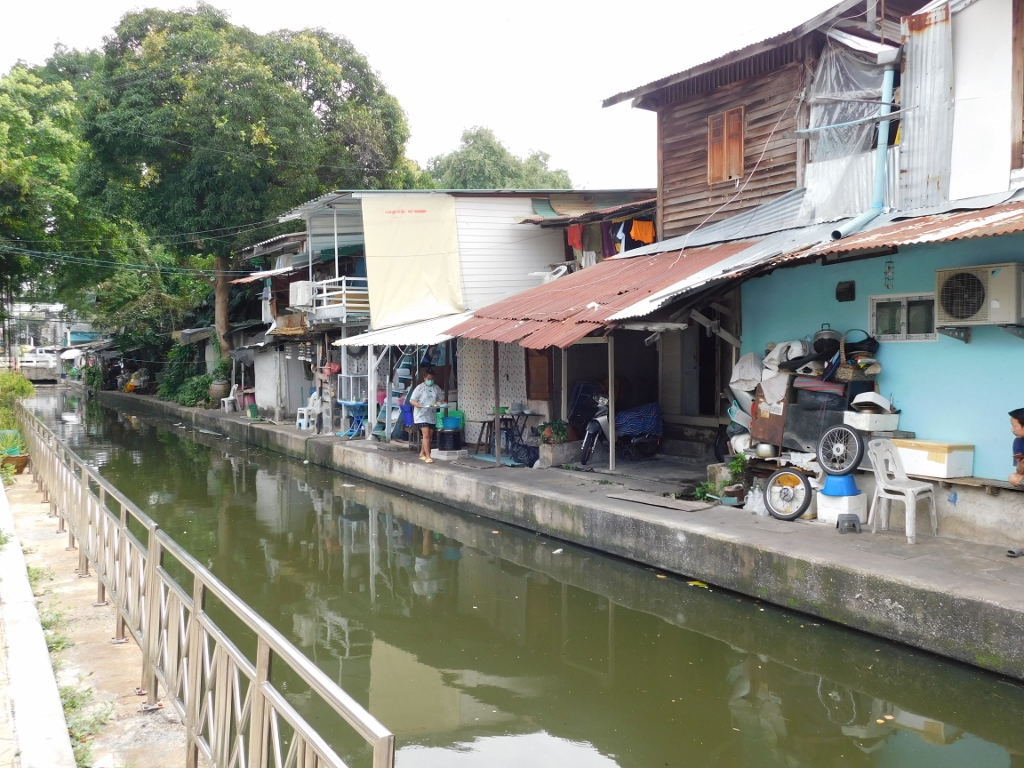 One of the numerous canals in Bangkok
One of the numerous canals in Bangkok
Here is also a well-known market with various Buddhist amulets and trinkets that are placed either on small home shrines or are taken to large public temples.
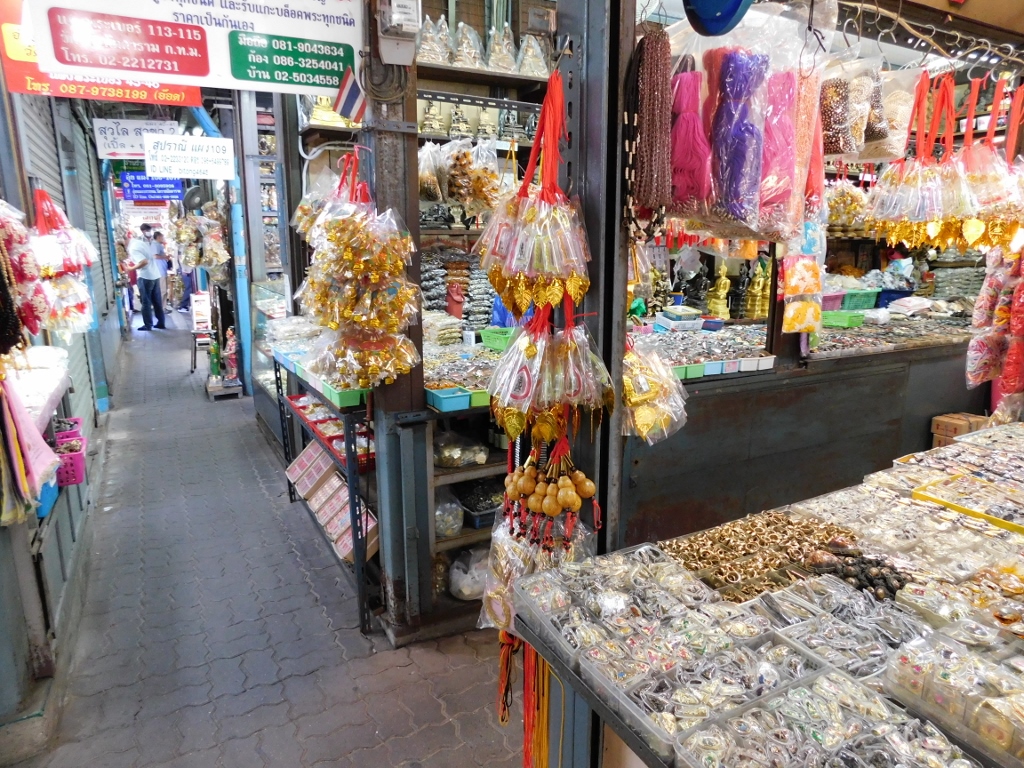 Amulet market
Amulet market
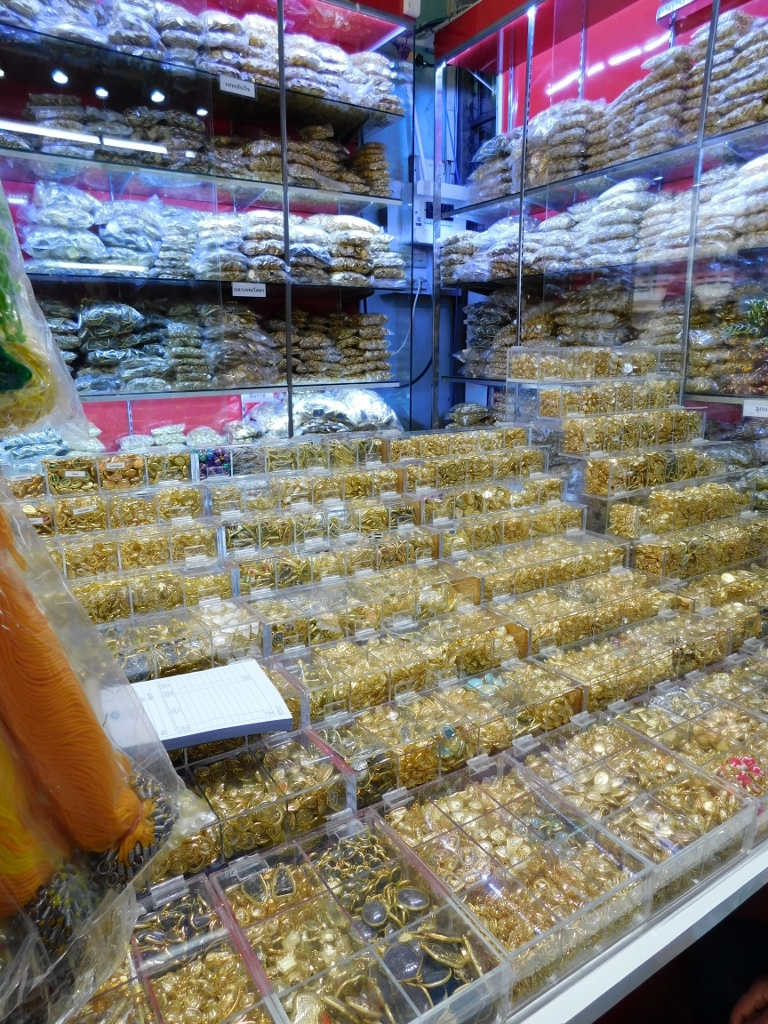 Amulet market
Amulet market
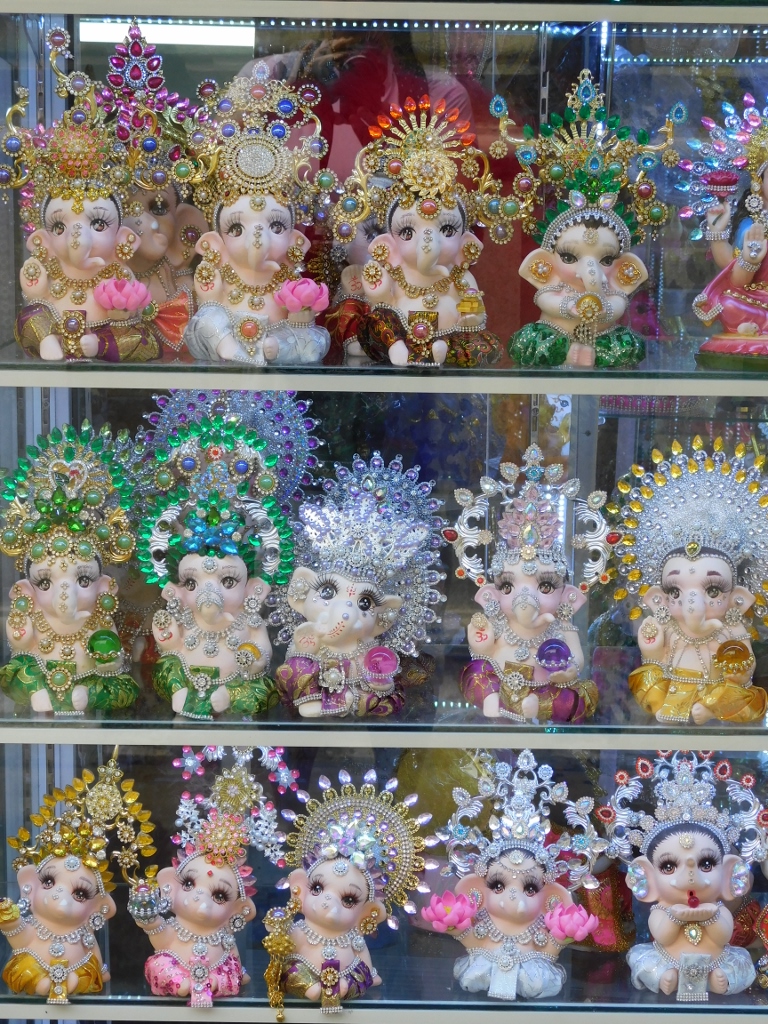 Amulet market
Amulet market
I continued from here towards the main destination of the day, which was the Golden Mount. However, first, I crossed again a wide boulevard adorned with pictures of members of the royal family and then I passed by the Mahakan Fort.
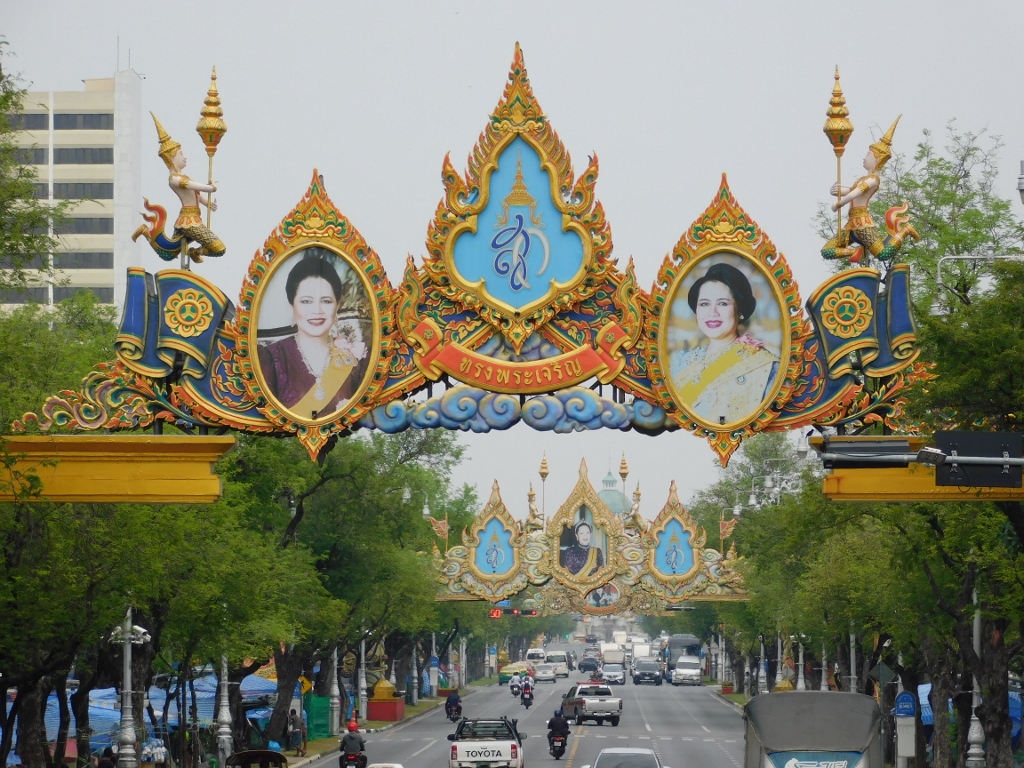 Bangkok, a detail
Bangkok, a detail
This fortress is a remnant of the fortifications that surrounded Bangkok from 1782 when King Rama I assumed power, marking the beginning of the Chakri dynasty, which still formally rules Thailand today.
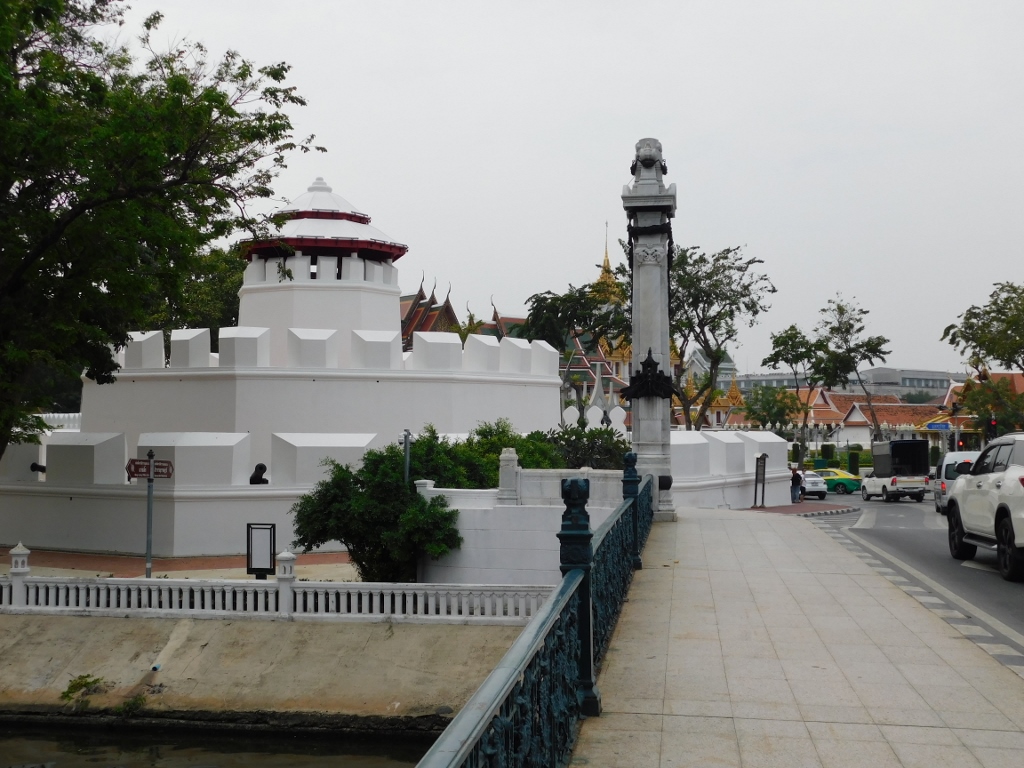 Mahakan Fort
Mahakan Fort
Upon assuming power, Rama I (b/r 1737/1782-1809) ordered the construction of a moat on the eastern side of the city that had now become the capital of his kingdom. Considering that the Chao Phraya River flows in the shape of an arch on the western side, Bangkok’s centre thus became an island and it is called Rattanakosin Island. The moat still exists today, but now functions as one of the many canals. It is the same canal next to which the hotel where I stayed on this occasion was located.
I have now crossed it using the Phan Fa Lilat Bridge, which spans the former moat turned canal. The bridge is practically visible in the previous photo that I took while standing on it and one of its distinctive features is the marble pillars at its ends. Although the bridge has undergone numerous changes over time, its basic, old elements still exist today. Therefore, the bridge is registered as a national heritage and I mention it here in that capacity. It can be seen on the far right in the picture below.
 Former outer moat and the Phan Fa Lilat Bridge
Former outer moat and the Phan Fa Lilat Bridge
As I mentioned earlier, I was now going to the Golden Mount. It is an artificial hill. During the reign of King Rama III (1834-1851), the construction of a large stupa began at this site. However, the ground here was quite soft and couldn’t bear the weight, so the stupa under construction collapsed at some point, forming a mound of mixed mud and bricks. Over time, vegetation started covering the artificial hill. Then, King Rama IV (1851-1868) erected a small stupa on top. The succeeding king, Rama V (1868-1910), also contributed to the construction of the newly formed structure, in addition to which he incorporated a Buddha relic from India, which he received from the British in 1897, into the stupa. During World War II, concrete walls were added to prevent erosion of the hill. Considering the nature of the terrain, the entire structure and everything visible here are truly impressive. Moreover, it’s a good idea to come here and climb to the top of the hill, not only if you’re a Buddhist or interested in temples, but also because this is the only hill in Bangkok, offering a wonderful panoramic view in all directions from the top.
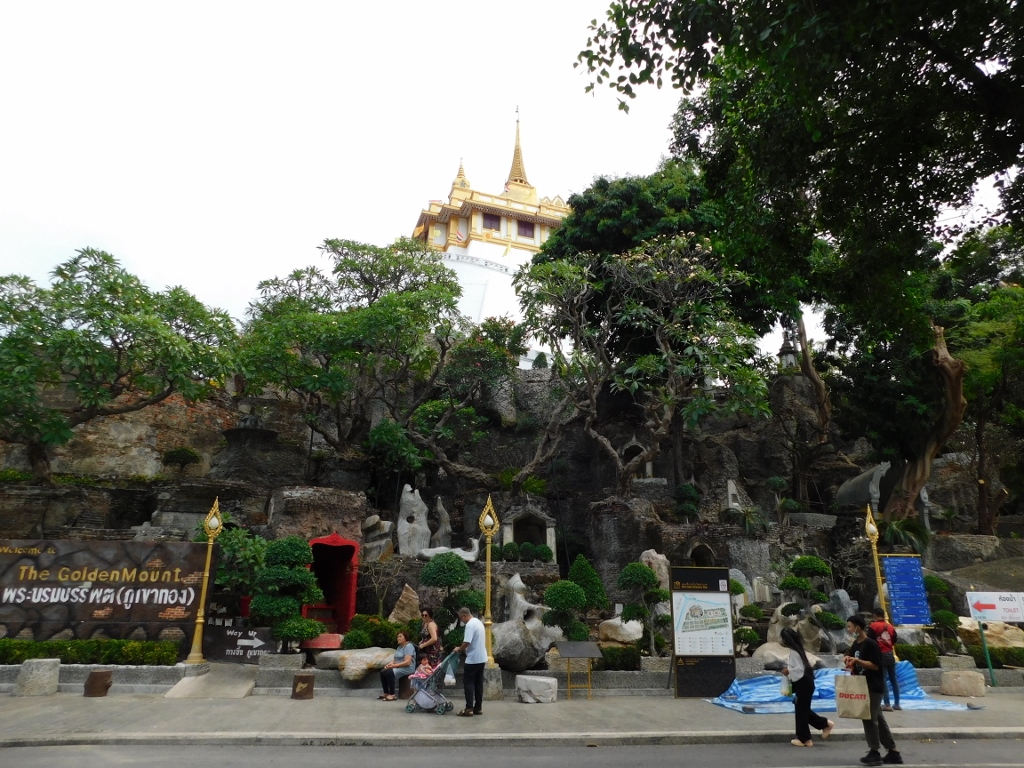 At the foot of the Golden Mount
At the foot of the Golden Mount
By the way, here is the map of Bangkok that I made specially in order to mark the sites that I visited in this huge city.
Around the Golden Mount, there is a wide street and you need to turn right to reach the ticket office and buy tickets. Almost at the beginning of this ‘circular route’ around the Golden Mount, you come across a shrine with a statue of the Buddha placed there for believers who cannot climb to the top of the hill. This representation of the Buddha has a specific name and symbolism, but I won’t go into that level of detail now. If I were to read and then write about every Buddha statue I saw, I would almost certainly never finish writing these stories.
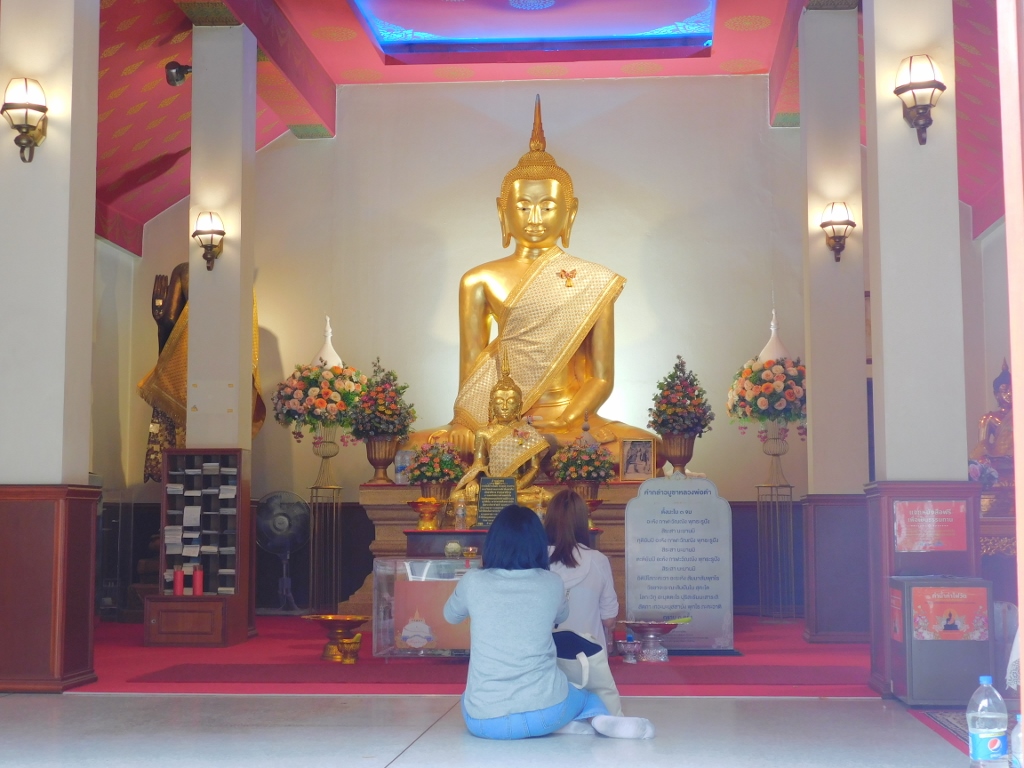 Buddha shrine at the foot of the Golden Mount
Buddha shrine at the foot of the Golden Mount
Right next to the shrine is a place where you can practically buy thin golden leaves on which a wish or message can be written and then this is hung on a special structure. Often, these leaves come with a small bell and since the leaves are light, even a gentle breeze moves them and they “dance” in the wind. I assume that in this way, they invoke energies better and lead to the fulfilment of wishes or the spreading of positive messages in the world. This was new to me, so, on the one hand, I didn’t think too much about whether the leaf is formally bought or one gives a donation and then a leaf is taken in exchange for that. On the other hand, since I’m not a Buddhist, I didn’t even try to please the Buddhist spirits in this way.
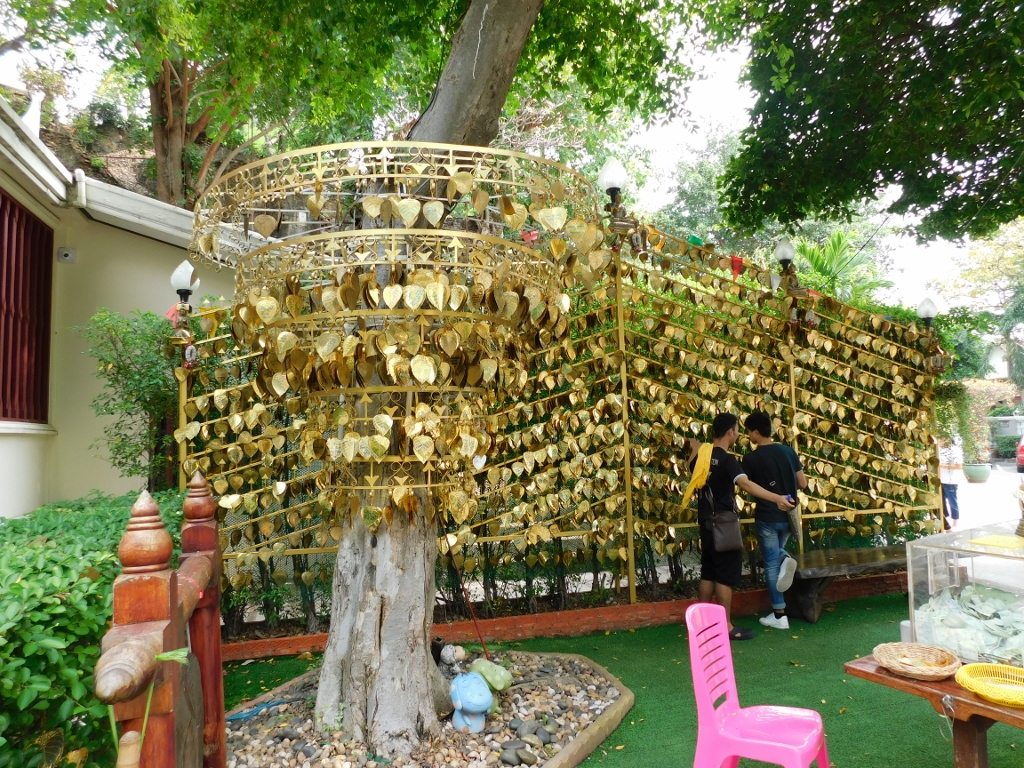 Lots of wishes at the foot of the Golden Mount
Lots of wishes at the foot of the Golden Mount
But there are also visitors who approach spiritual rituals in a more conventional way – through direct prayer. At the base of the Golden Mountain, there are several places where believers can perform their spiritual rituals and shrines appear in various forms.
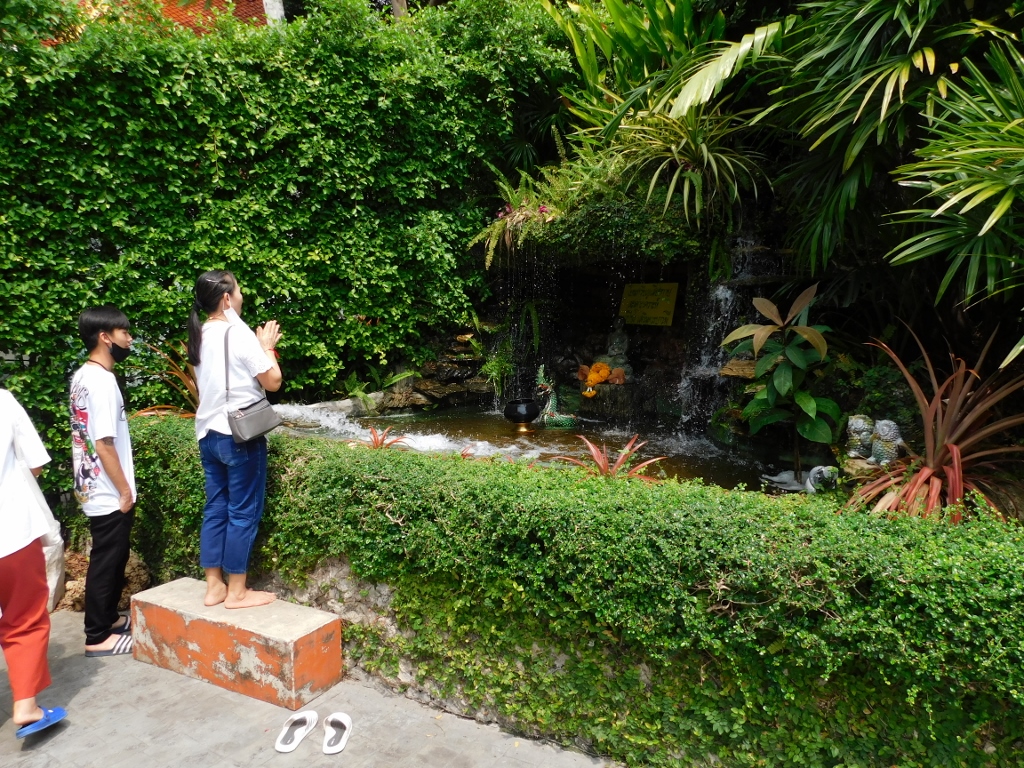 Prayer at the foot of the Golden Mount
Prayer at the foot of the Golden Mount
After buying a ticket, the visitor should be prepared to climb the Golden Mount – to reach the top you need to climb 344 steps. That’s what it says at the beginning and besides, from the foot of the elevation you can clearly see the temple on the top to which these steps lead.
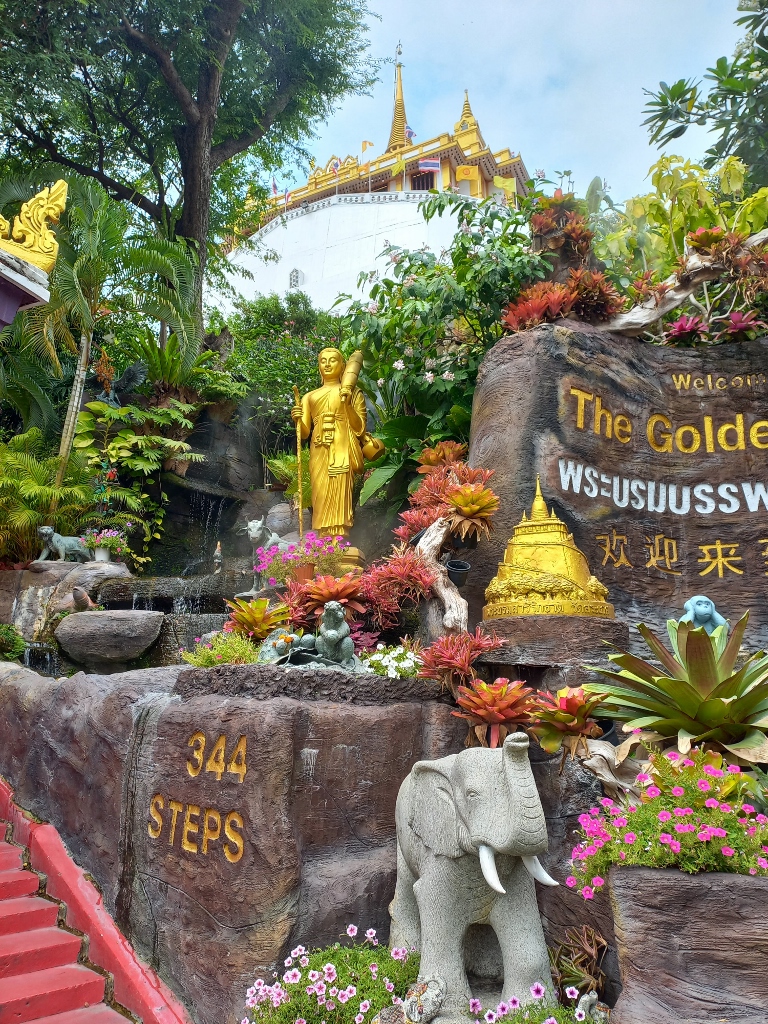 Beginning of the ascent to the top of the Golden Mount
Beginning of the ascent to the top of the Golden Mount
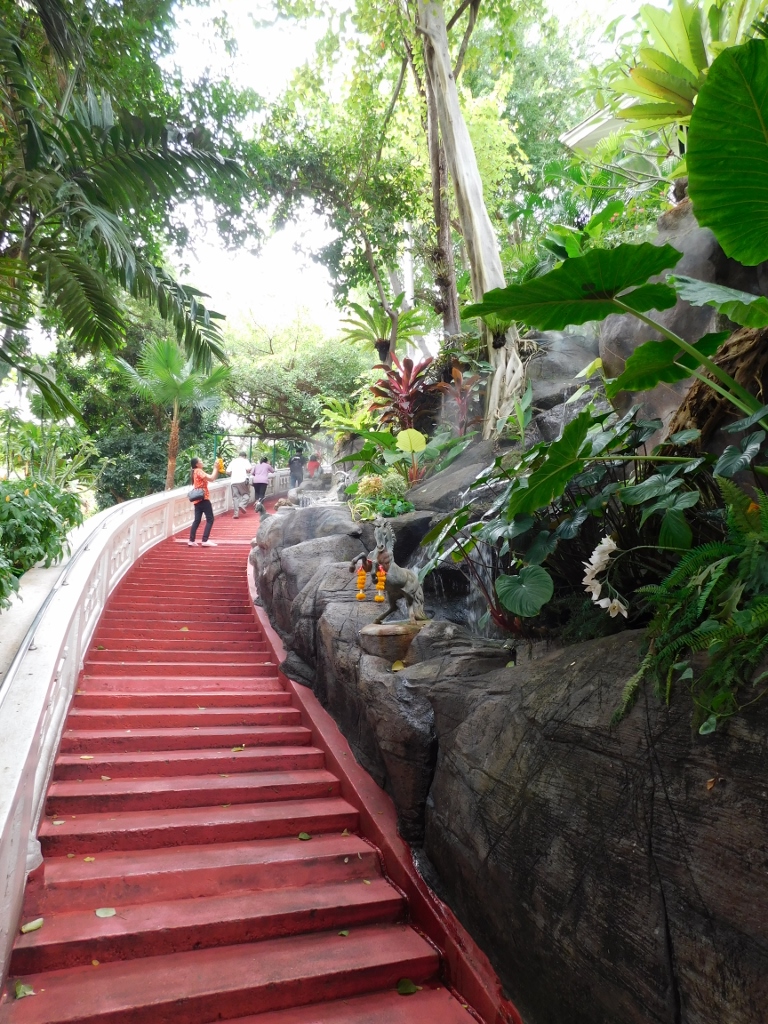 Steps leading to the top of the Golden Mount
Steps leading to the top of the Golden Mount
During my visit to the Golden Mount and later, while writing these stories, I came across some information that was entirely unclear to me or rather confusing. Separate from the Golden Mount, there is mention of the Wat Saket temple and at the same time these two terms are often used in the same context. Although I could certainly not assert, from what I managed to understand, there is actually a large monastery-temple complex here called Wat Saket. It encompasses the flat part where Wat Saket temple with the main and auxiliary temple structures is located. Still, the complex also includes the Golden Mount with a shrine at the top, as well as a series of smaller temples and shrines.
So, I started climbing the stairs to the top of the Golden Mount and alongside them, there are numerous small waterfalls and pools, as well as various Buddhist figures, each carrying its symbolism.
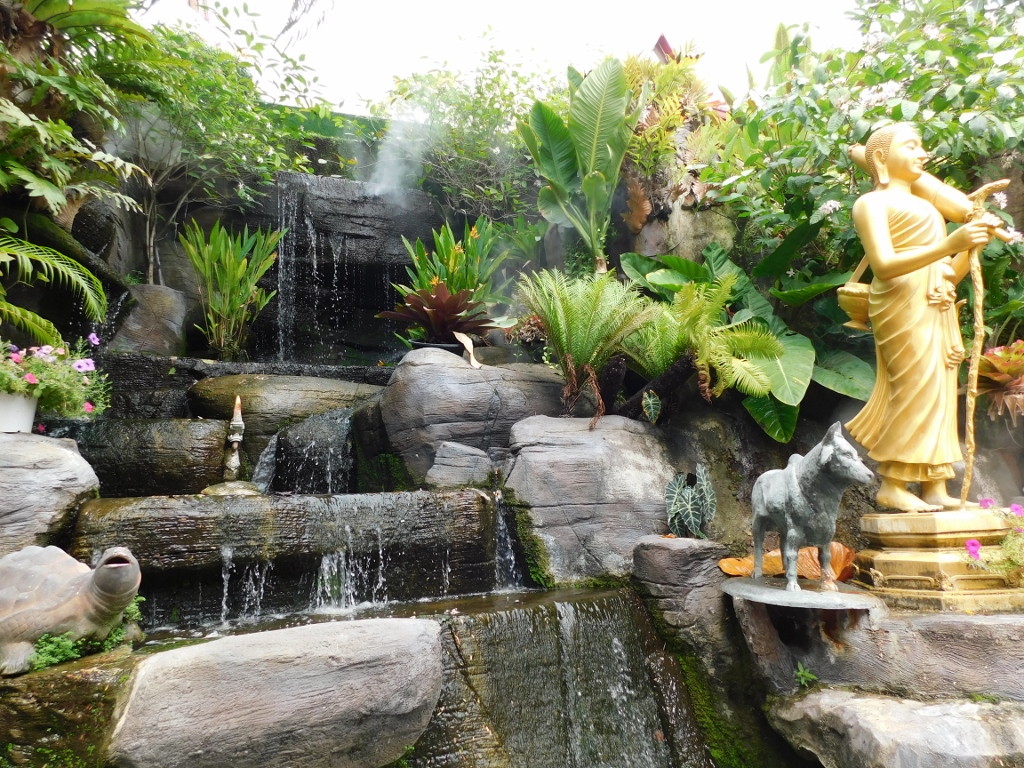 Golden Mount, a detail
Golden Mount, a detail
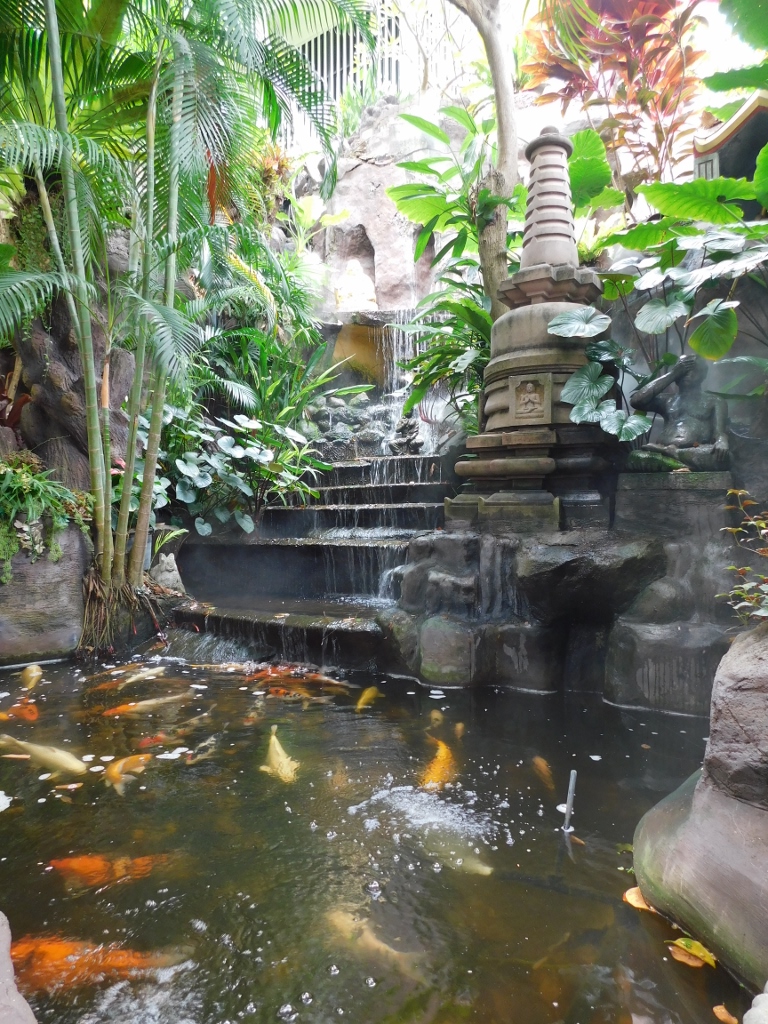 Golden Mount, a detail
Golden Mount, a detail
This climbing did not sit well with me at all because I was still tired from the journey and the heat had started to rise along with high humidity. I felt mostly exhausted. I wasn’t hungry, but I thought it would be good to eat something. Next to the stairs, I found a café, so I sat down there to have a tasty cake and a refreshing cold lime tea, which suited me perfectly.
Then I reached the flat part on the west side of the elevation, where large bells are located. Of course, I had to ring them a bit, but I didn’t overdo it. These bells are generally used to summon good luck or simply make a wish.
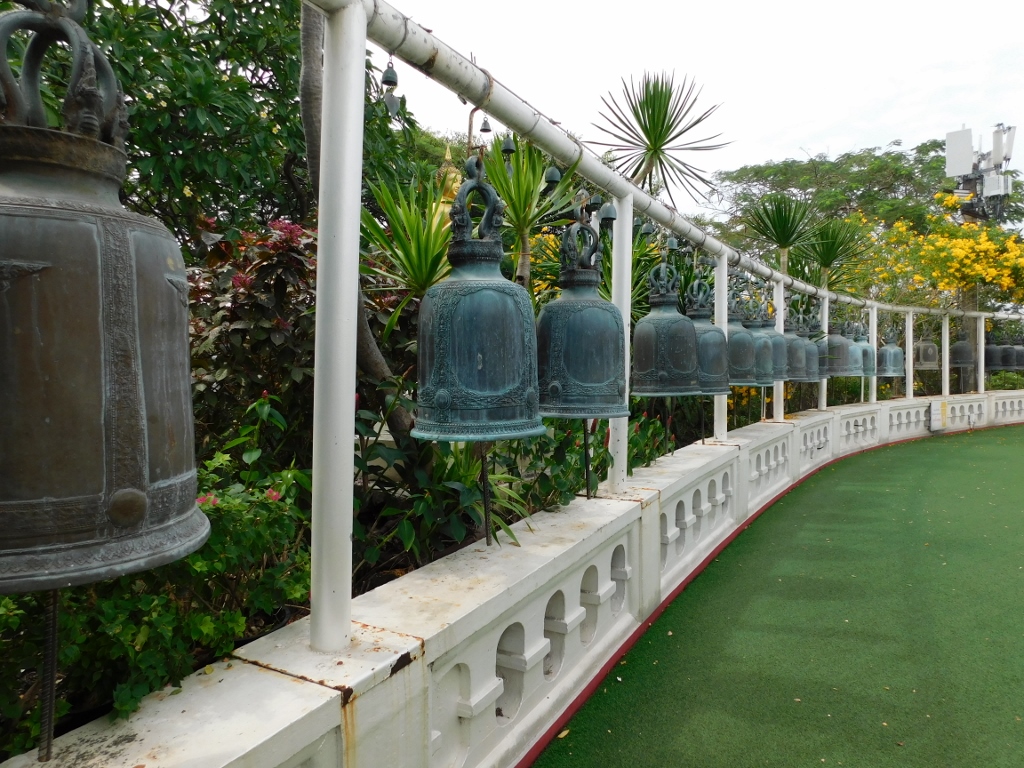 Golden Mount, a detail
Golden Mount, a detail
While I was taking pictures there, tiny dispersed droplets started to come out of the horizontal pipes, almost like mist, only these droplets felt like a refreshing touch.
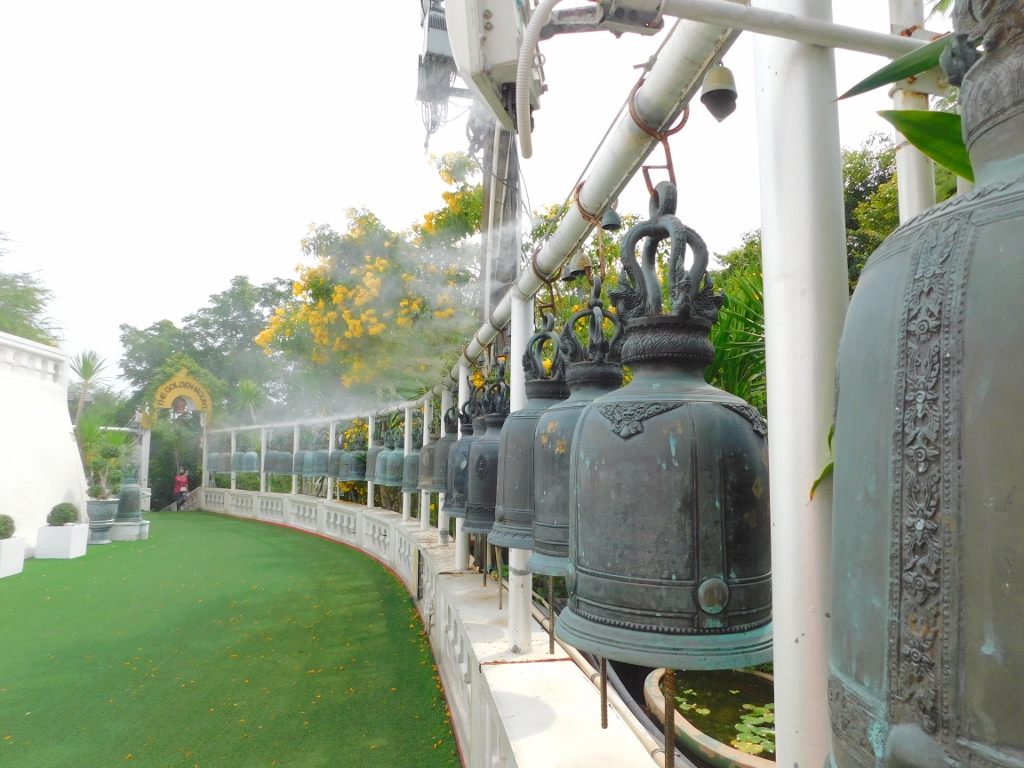 Golden Mount, a detail
Golden Mount, a detail
From this flat part, you can see the top of the hill and the shrine that is erected there, and then the staircase begins again.
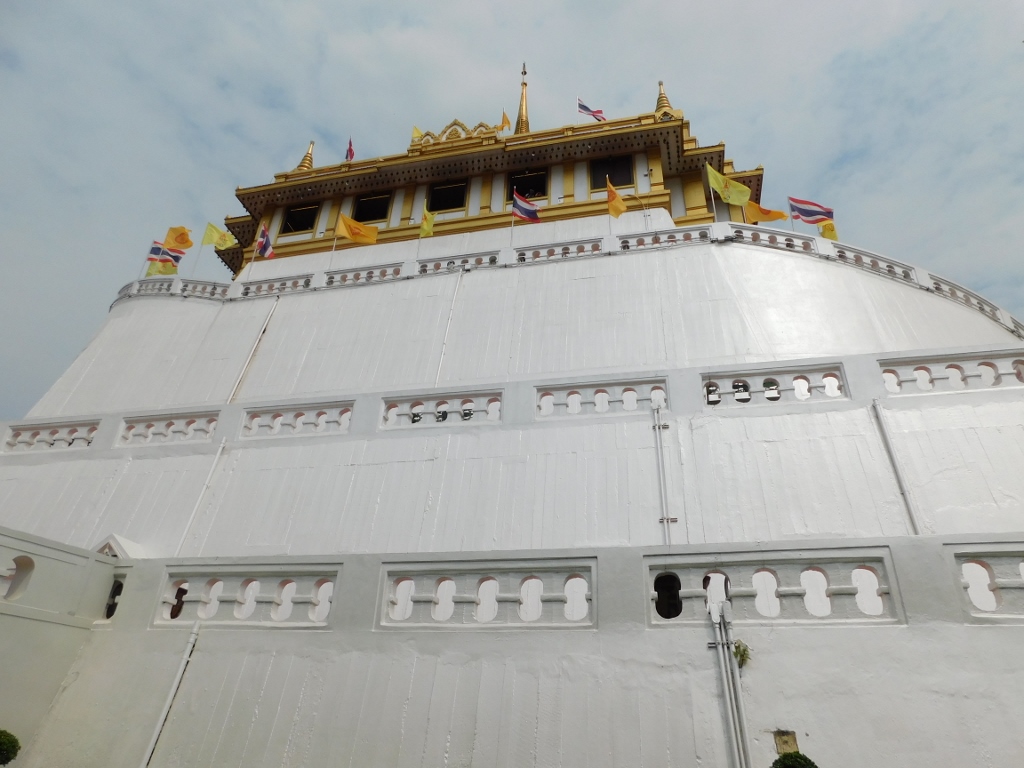 Golden Mount, a detail
Golden Mount, a detail
As the staircase spirals around the elevation, you soon reach the eastern side, where there is also a flat area with bells.
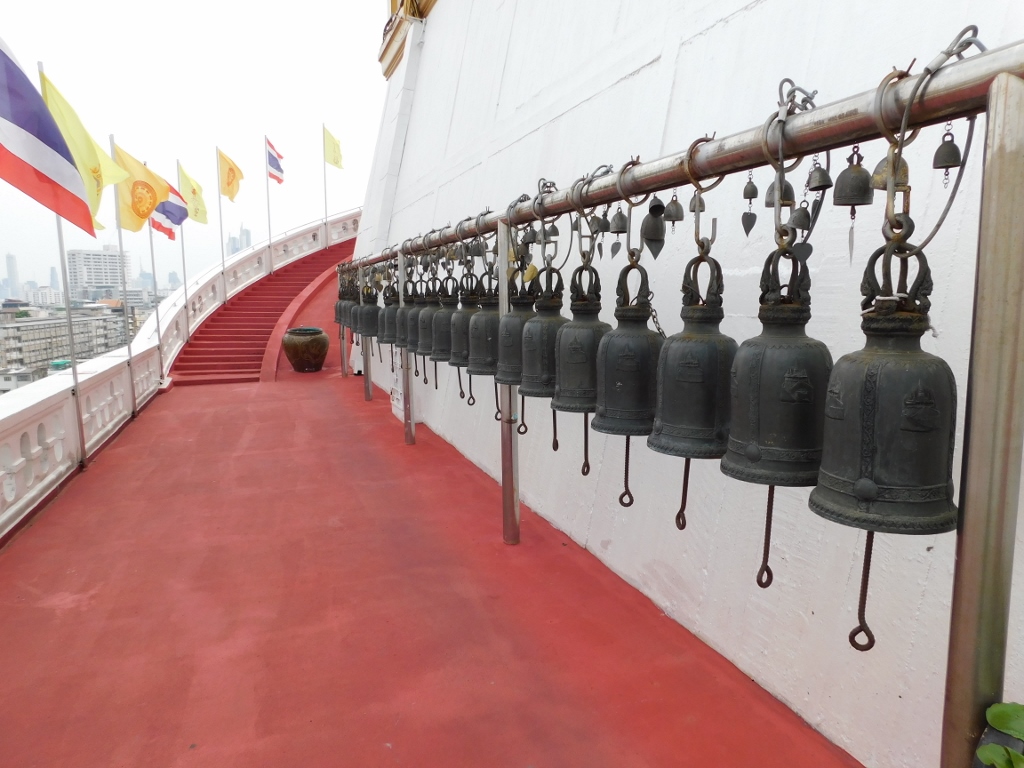 Golden Mount, a detail
Golden Mount, a detail
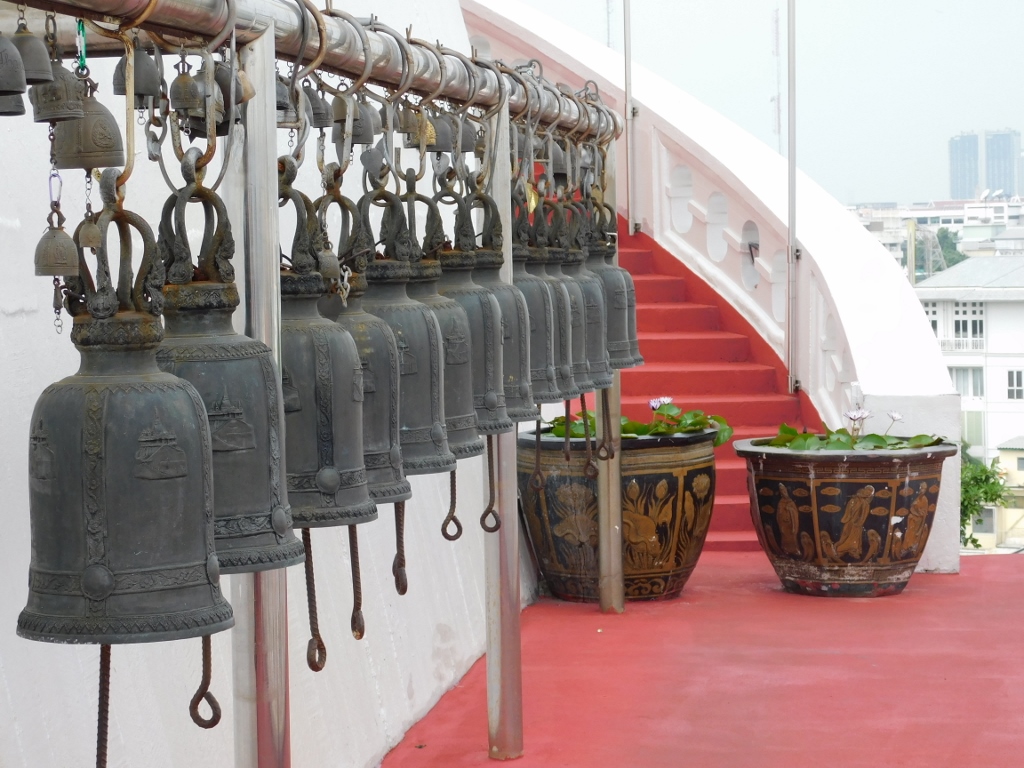 Golden Mount, a detail
Golden Mount, a detail
Here, I took a few photos and recorded with the video camera. The footage is far from exceptional, but it captures the atmosphere and sounds. On the other hand, you can see that there was some wind, although it didn’t do much to alleviate the high temperature and humidity.
From this flat area, however, you can see some parts of Bangkok, especially Wat Saket that is located just east of the Golden Mount.
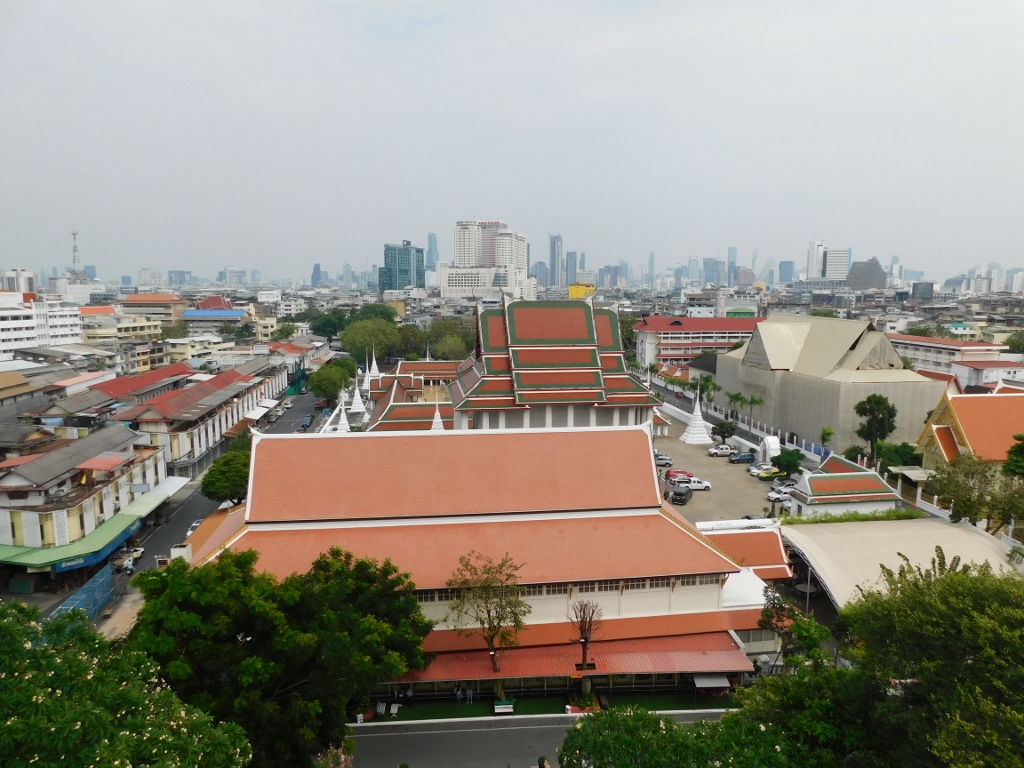 View at Wat Saket and some modern parts of Bangkok
View at Wat Saket and some modern parts of Bangkok
As I continued to climb the stairs towards the top, I could see numerous auxiliary temple buildings and other parts of Bangkok in the southern direction.
 View at the surroundings and parts of Bangkok south of the Golden Mount
View at the surroundings and parts of Bangkok south of the Golden Mount
Soon I reached the top of the Golden Mount, where a small shrine with numerous altars is located, along with a large stupa incorporating a relic of the Buddha, as I’ve mentioned before.
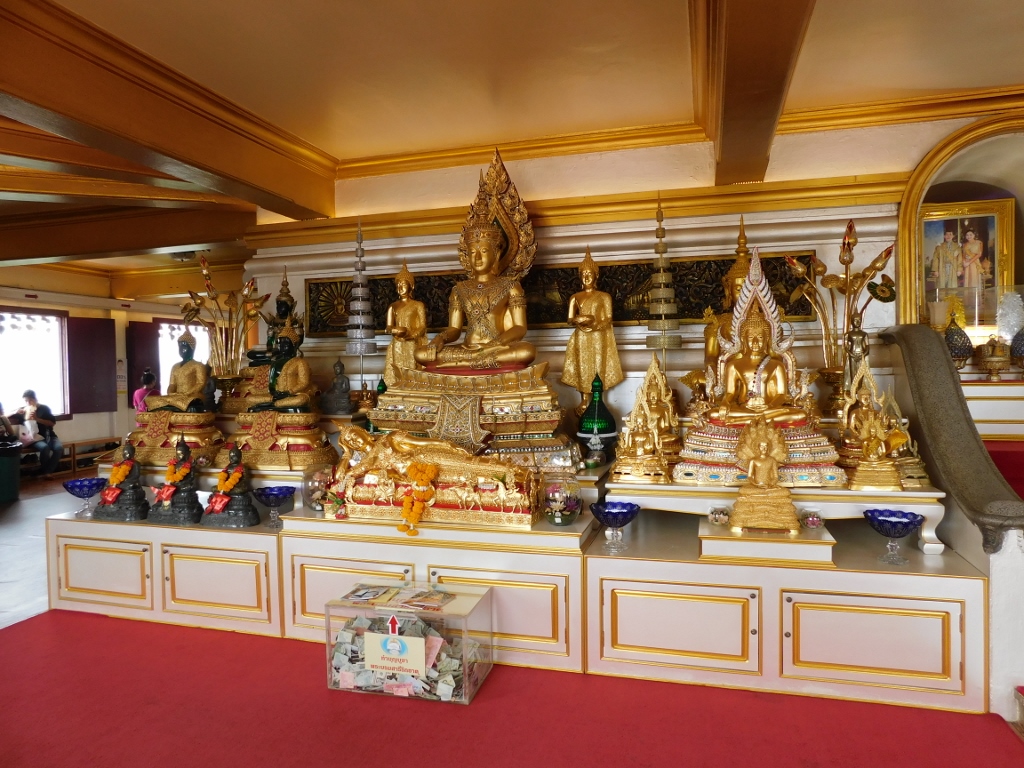 Golden Mount, a detail
Golden Mount, a detail
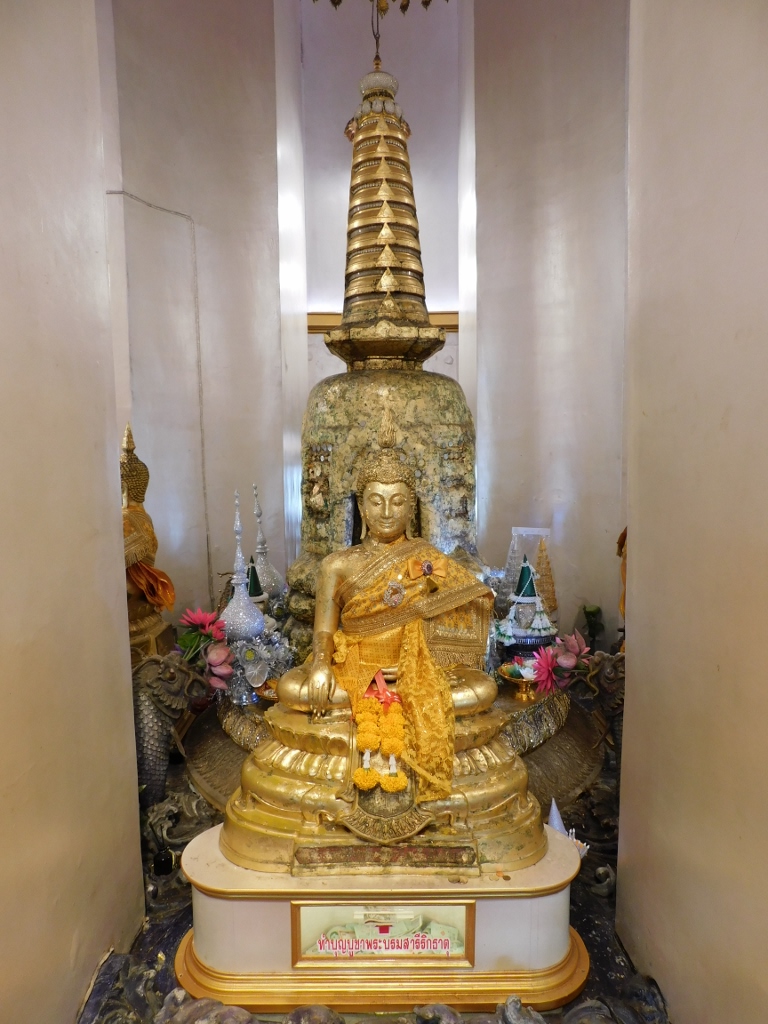 Golden Mount, a detail
Golden Mount, a detail
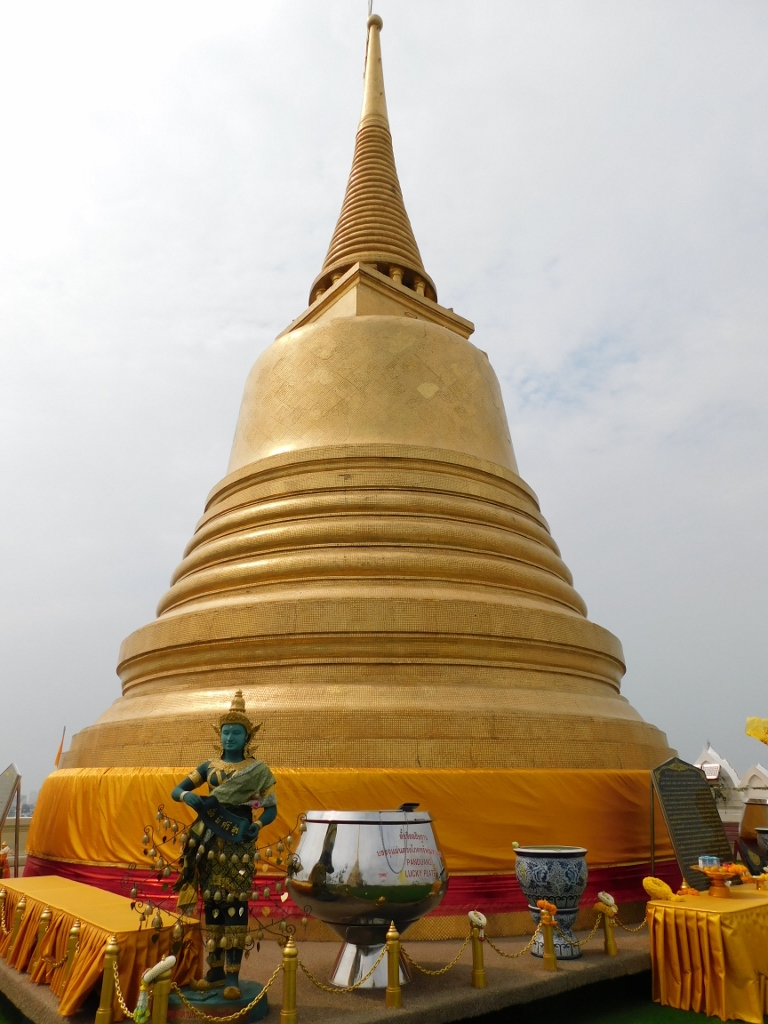 Stupa on the top of the Golden Mount
Stupa on the top of the Golden Mount
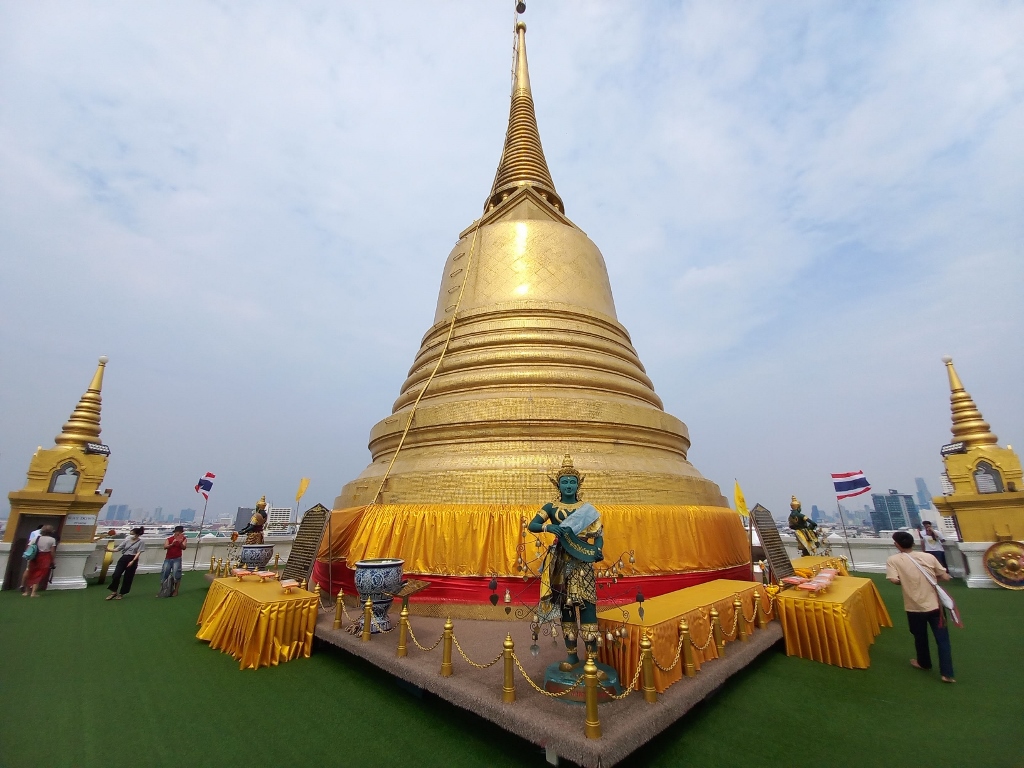 Stupa on the top of the Golden Mount
Stupa on the top of the Golden Mount
In addition to circling around the stupa on the top, this place is also worth the visit for its incredible views of all parts of Bangkok. I certainly enjoyed that, but it was also interesting to observe some people who brought offerings along with their prayers.
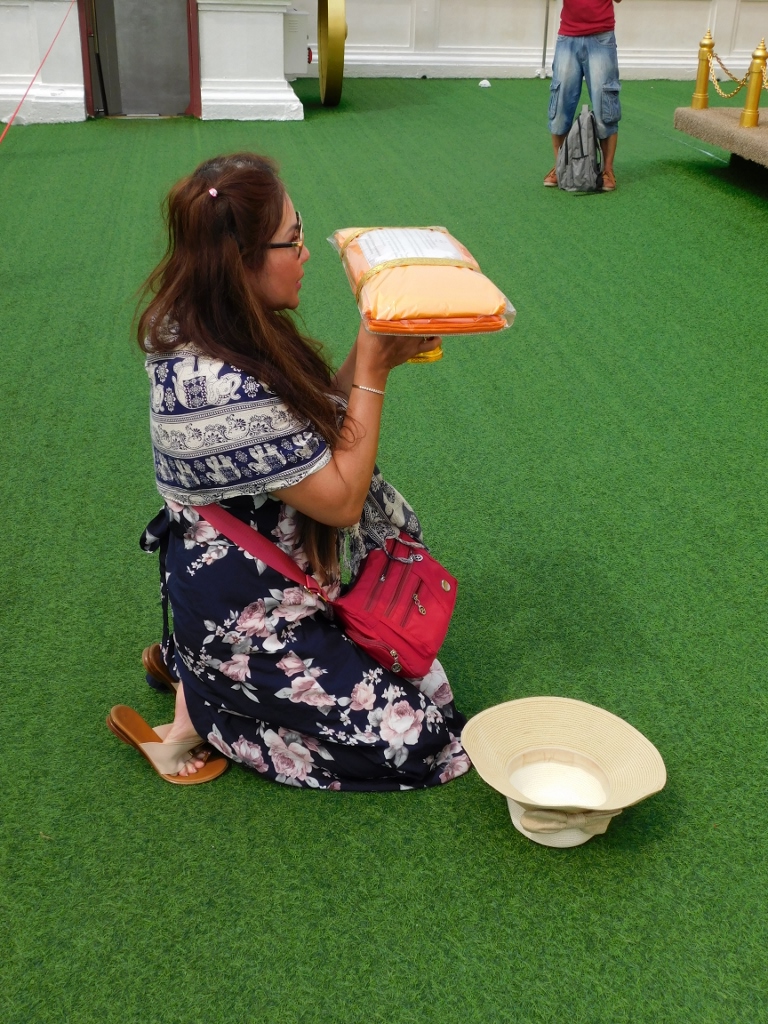 Golden Mount, a detail
Golden Mount, a detail
After a short stay on the top of the Golden Mount, I started to descend, using another set of stairs similarly constructed. On this occasion, I found it interesting to pay a bit more attention to the leaves and bells that serve to invoke the fulfilment of wishes, as well as to record all of that.
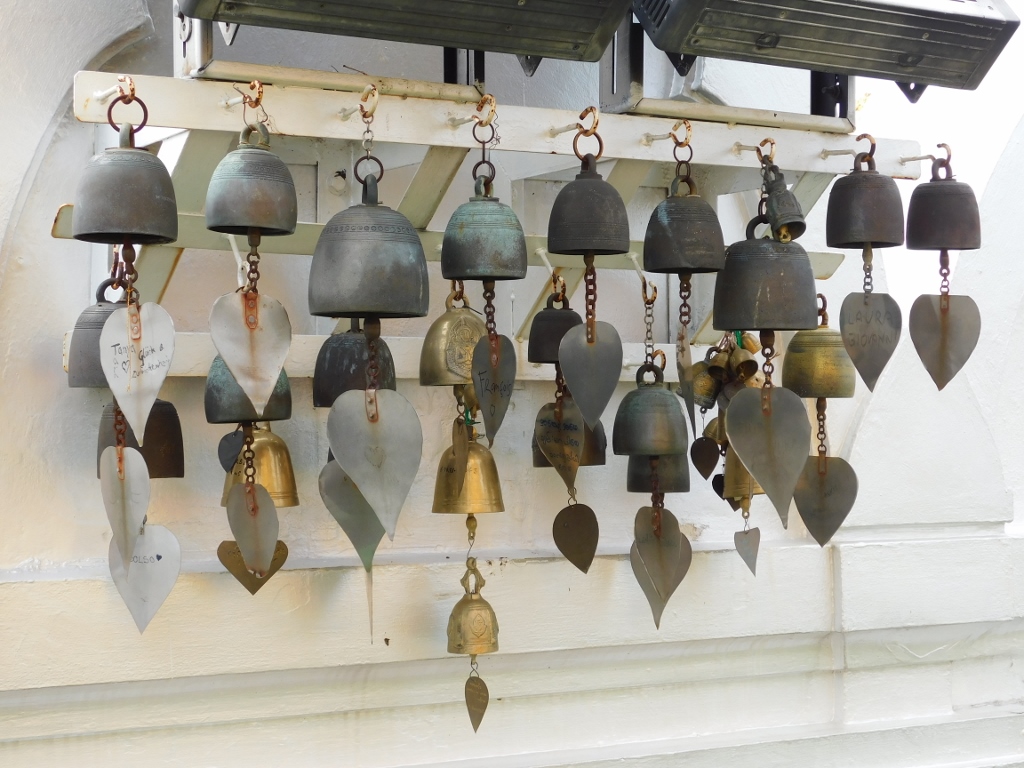 Golden Mount, a detail
Golden Mount, a detail
The path for descending from the top of the Golden Mount also passes by a couple of smaller temples and one of them is dedicated to vultures.
 Golden Mount, a shrine dedicated to the vultures of Wat Saket
Golden Mount, a shrine dedicated to the vultures of Wat Saket
The tradition in the Kingdom of Siam (present-day Thailand) was that corpses were not cremated within city walls. Since Wat Saket was located just outside the city walls, as regards Bangkok, the deceased were often brought here to be cremated. Then, in 1820, a major cholera epidemic broke out, resulting in about 30,000 deaths in the capital. All the corpses were brought here, but due to the inability to cremate them quickly enough, many were left in the open parts of the monastery. As a result, vultures appeared and simply devoured them, since these birds, as their name suggests, feed on carrion.
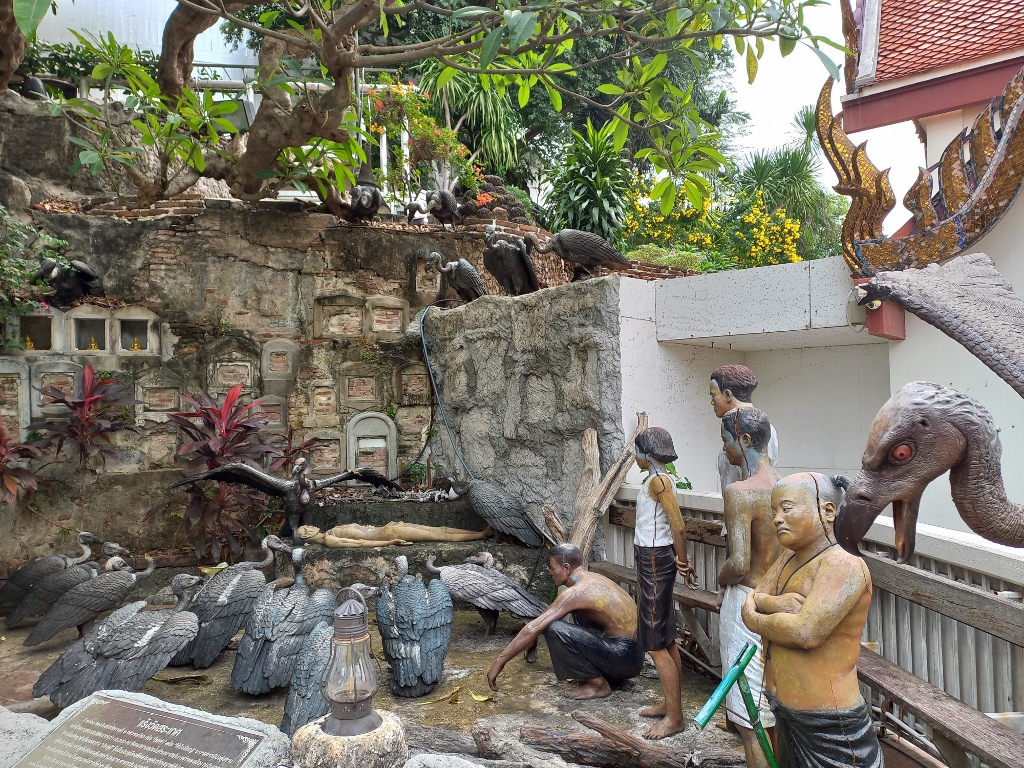 Picturesque details of the shrine dedicated to the vultures of Wat Saket
Picturesque details of the shrine dedicated to the vultures of Wat Saket
Cholera continued to appear every year to a greater or lesser extent, with the worst situation being in 1840 when literally every tenth inhabitant of Bangkok died from this disease. The last recorded cholera epidemic was in 1881. However, as vultures came here every “cholera season,” they became a common sight and today, near a smaller shrine, there is a sculptural representation of scenes evoking these events.
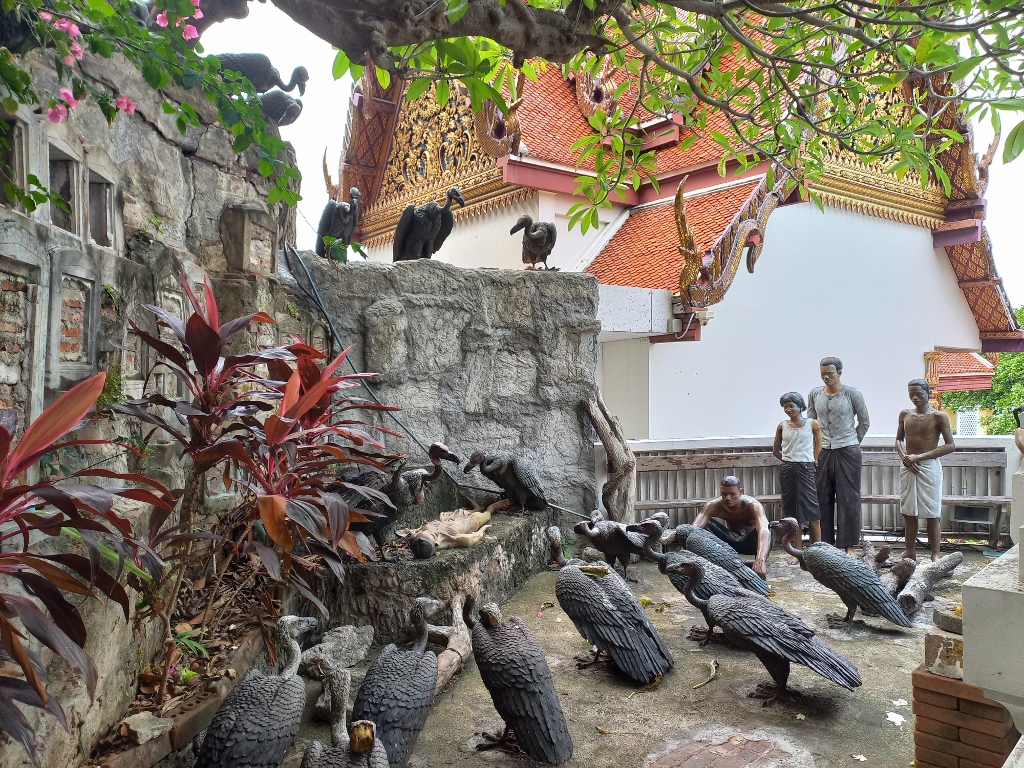 Picturesque details of the shrine dedicated to the vultures of Wat Saket
Picturesque details of the shrine dedicated to the vultures of Wat Saket
Today in Bangkok, there are no more cholera epidemics, but there are no vultures either. They no longer come to Thailand.
At the Golden Mount, there is also Luang Phor Toh vihara/viharn (smaller temple) which houses a gilded statue of the Buddha in a meditation posture, 4.5 metres high. Devotees come here to pray and express their respect for the Buddha statue, known as Luang Phor Toh (hence the sanctuary’s name). It is believed that this Buddha “prevents bad things from happening and provides happiness and joy to all.”
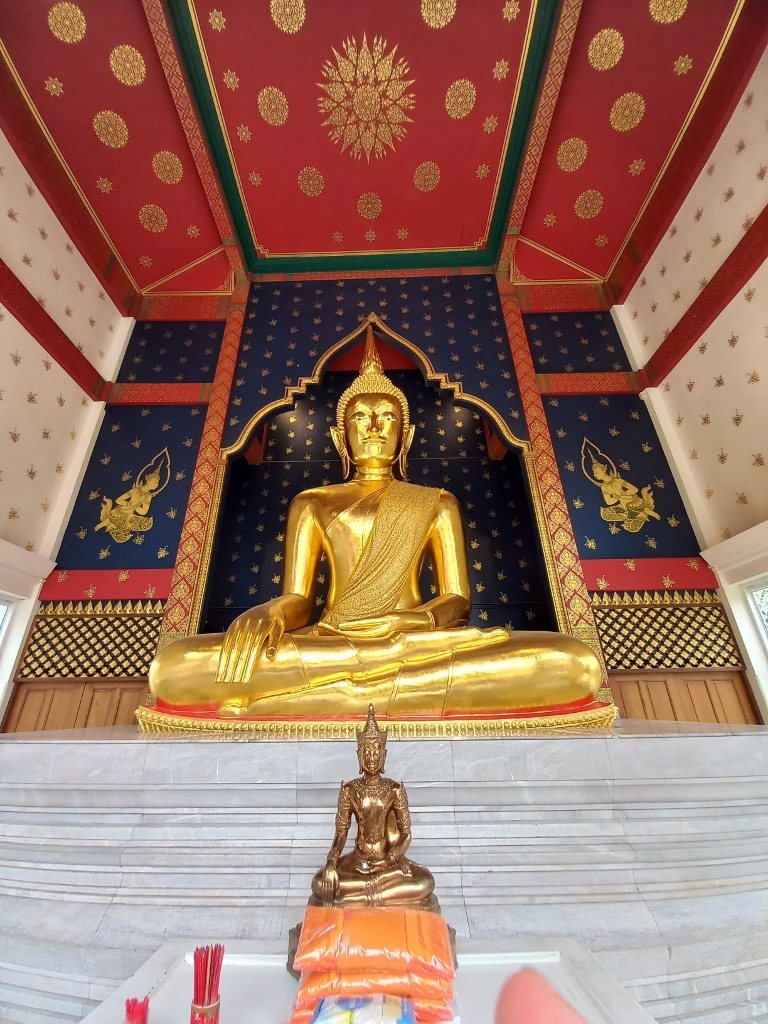 Luang Phor Toh
Luang Phor Toh
The offerings presented to the Buddha can be purchased on the spot. The cloth for the monks or a bag of rice costs just under 3 euros.
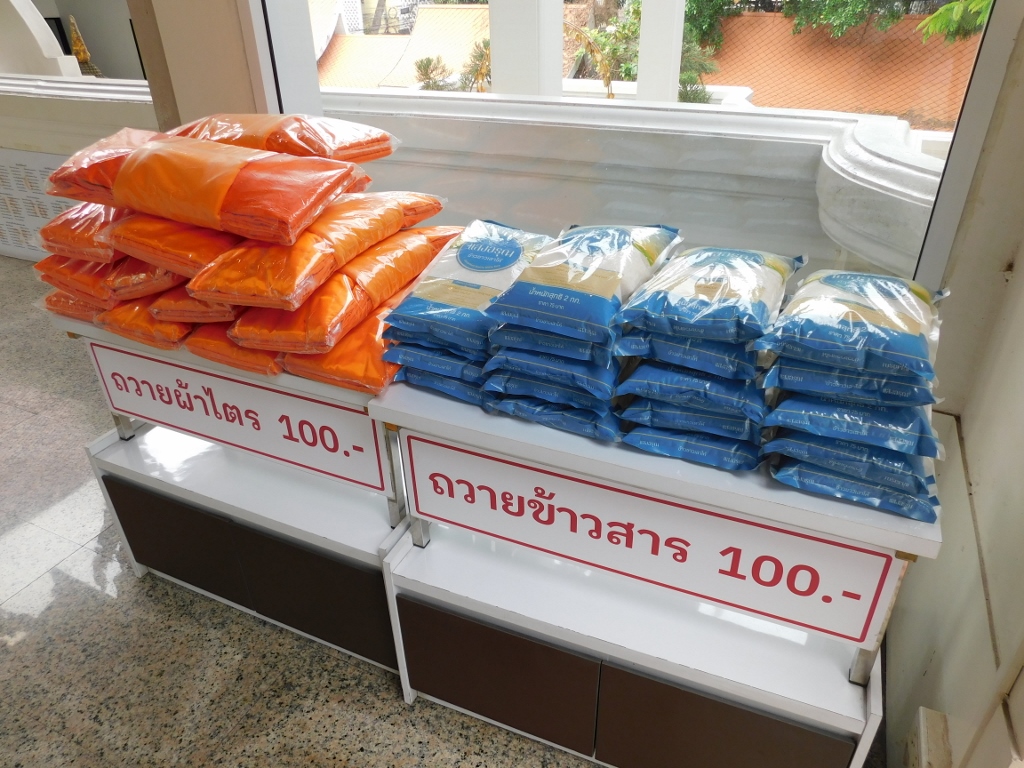 Offerings at the Luang Phor Toh vihara
Offerings at the Luang Phor Toh vihara
Then I got down to the level of the street that goes around the Golden Mount and thus I arrived at the eastern side of the elevation.
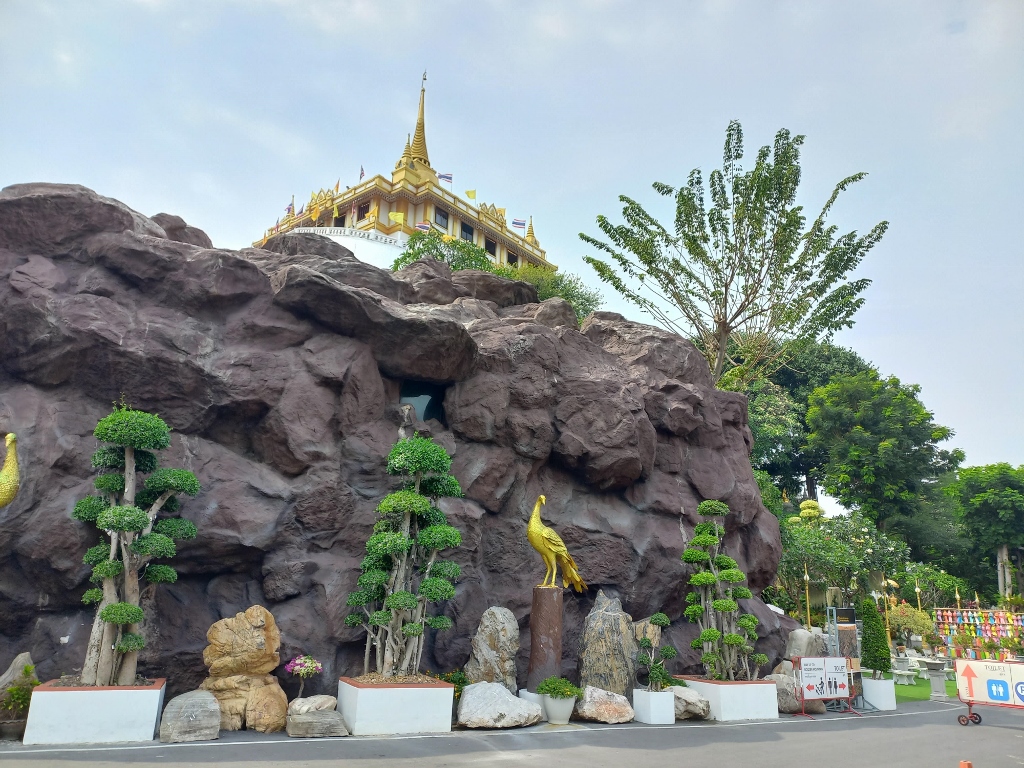 Golden Mount, a detail
Golden Mount, a detail
Here, one can see a construction resembling rocks, as if it is part of a rocky mountain. You can go through the “mountain” since there is a large “hall” in the centre and there is actually the Bamiyan Museum. Although I didn’t find any significant information about this “museum,” based on the name and partly the appearance of this hall and the large standing Buddha figure, I concluded that the inspiration for the museum came from the Buddha statues in Bamiyan, Afghanistan, which the Taliban destroyed several years ago.
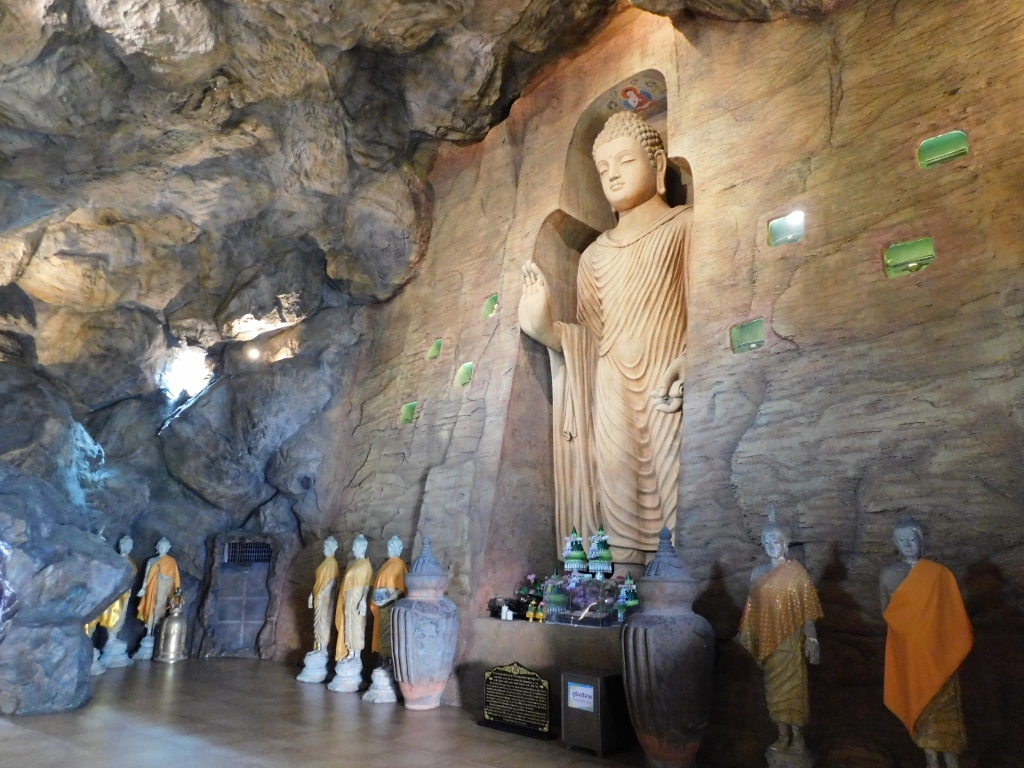 The Bamiyan Museum
The Bamiyan Museum
Also, in several places, smaller Buddha figures can be seen and in front of them pieces of glass are placed. I cannot confirm this, but it somehow seems to me that these are indeed pieces of glass imitating precious stones. If these are real precious stones, then they are impressively large.
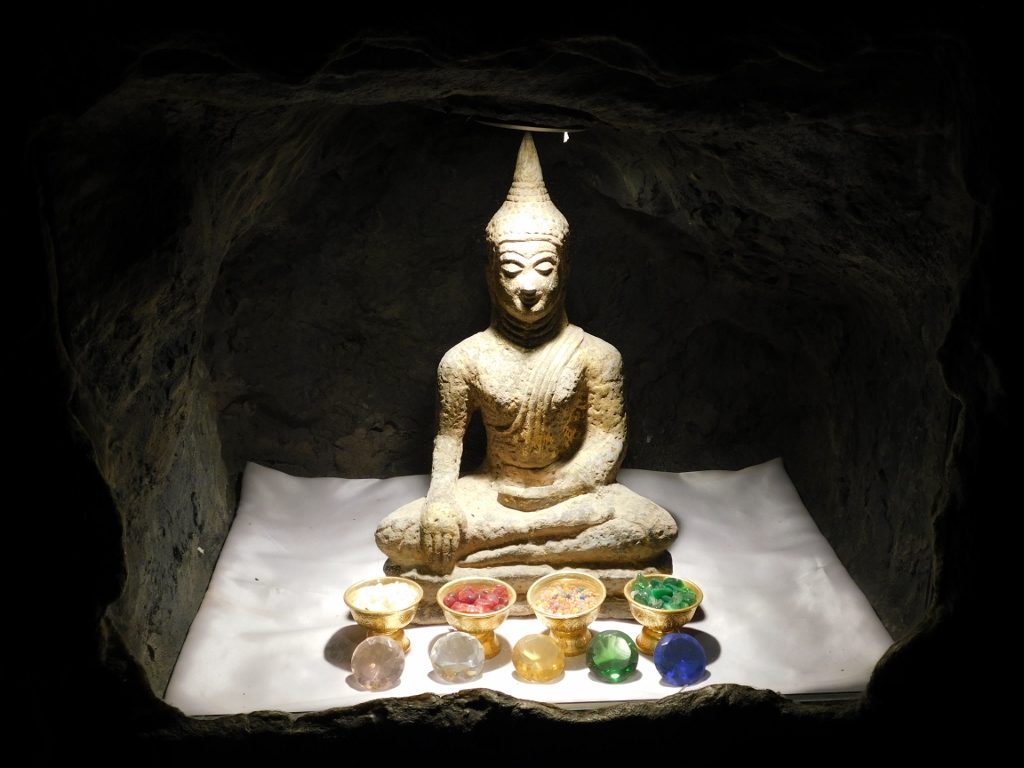 The Bamiyan Museum, a detail
The Bamiyan Museum, a detail
Then I went out to the open space and walked past another building that belongs to the Wat Saket monastery-temple complex, and that is the Tripitaka Hall.
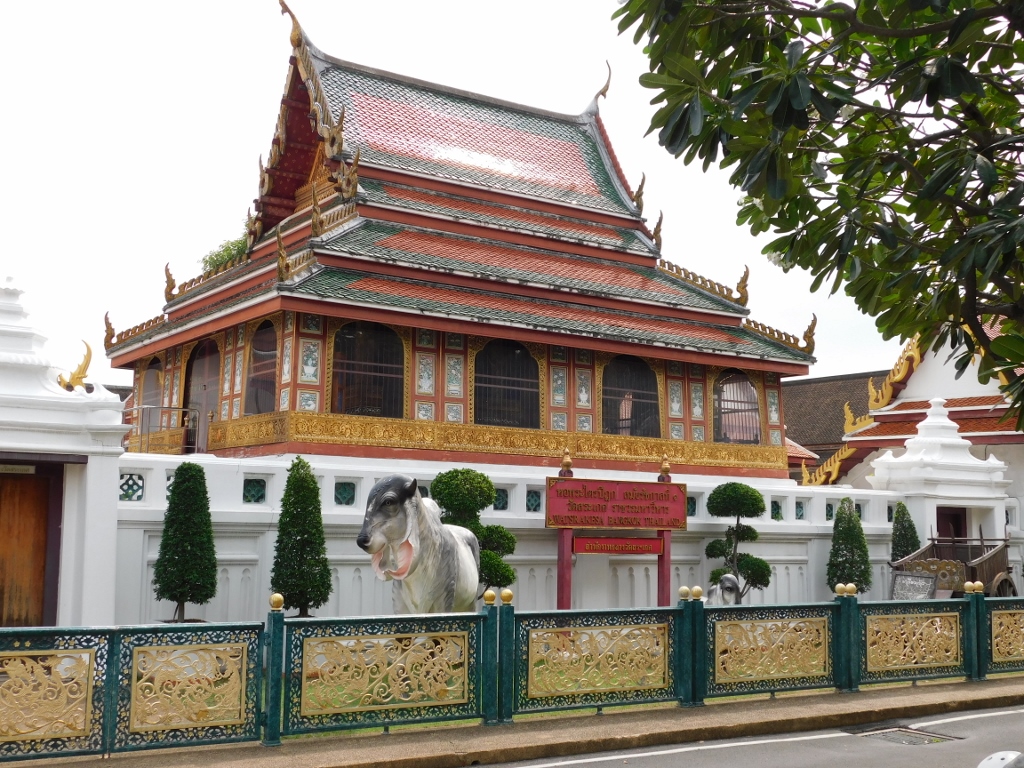 Tripitaka Hall
Tripitaka Hall
Now, I was actually heading towards the main Wat Saket temple, but let me clarify this once again. The entire monastery-temple complex is called Wat Saket and it is one of the oldest temples in Bangkok. What is often marked on maps as Wat Saket Temple are actually two important and large structures that are just part of the overall complex. One is the vihara and the other is the ubosot. First, I came to the vihara, which houses a large standing Buddha statue.
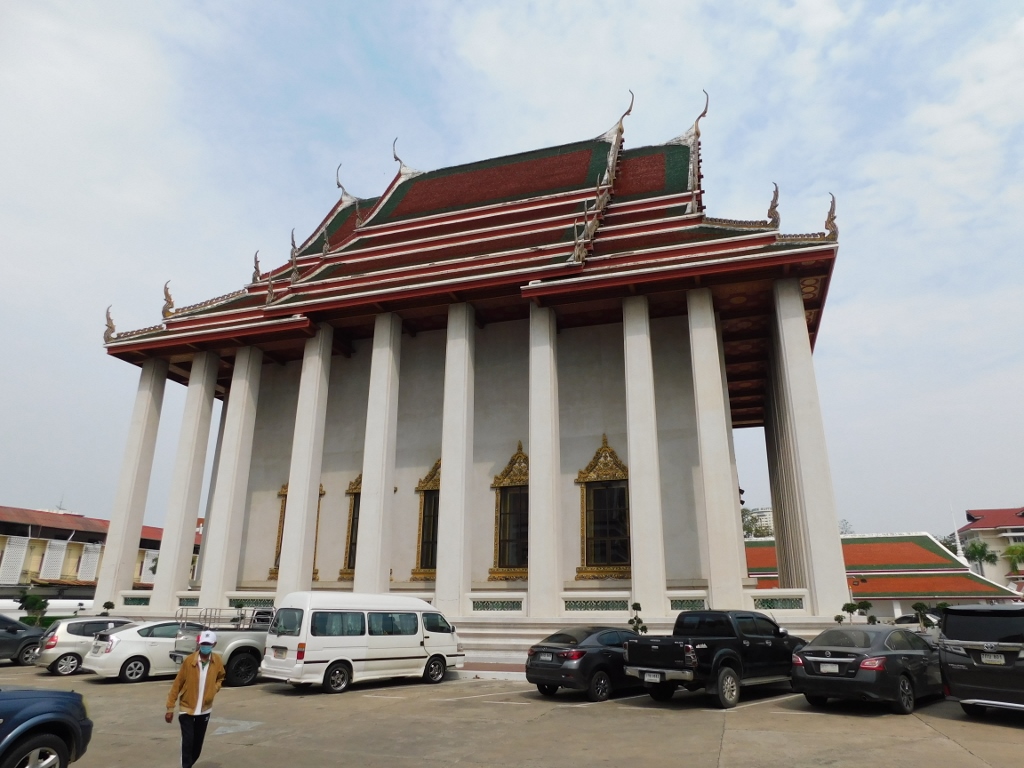 Vihara belonging to the Wat Saket
Vihara belonging to the Wat Saket
In fact, after the visitors have removed their shoes (it is absolutely unacceptable to enter temples with shoes on), they first enter the antechamber where a seated Buddha is seen.
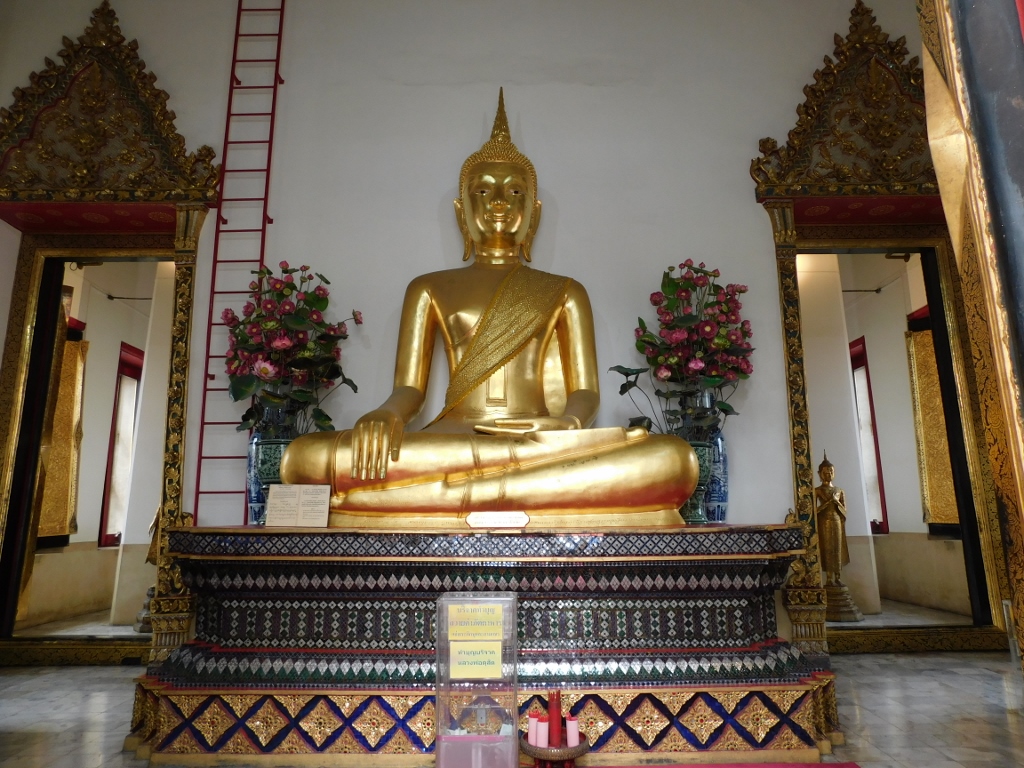 Sitting Buddha in the antechamber of the Wat Saket vihara
Sitting Buddha in the antechamber of the Wat Saket vihara
The standing Buddha figure is located in the main hall of the vihara.
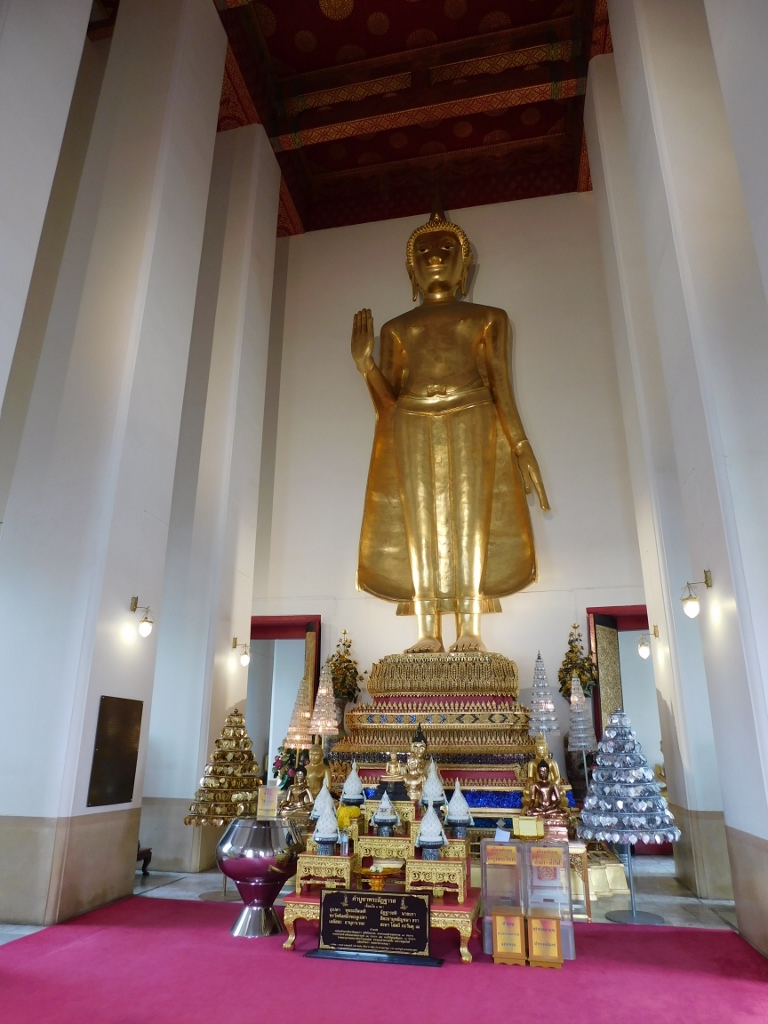 Standing Buddha in the main hall of the Wat Saket vihara
Standing Buddha in the main hall of the Wat Saket vihara
By the way, the vihara is located between the Golden Mount and the ubosot of Wat Saket that was the next structure I went to visit.
 Wat Saket: Golden Mount (left), vihara (middle), ubosot surrounded by a gallery (right)
Wat Saket: Golden Mount (left), vihara (middle), ubosot surrounded by a gallery (right)
I have already explained in the previous travel stories from Thailand what ubosot means, but for the sake of a reminder – it is the central building within the temple complex and it is used for various ritual ceremonies, including regular rites, prayers, meditations, reading of sacred texts, etc.
When I entered the courtyard around the ubosot, surrounded by a gallery, I was truly impressed by how everything looked beautiful and harmonious.
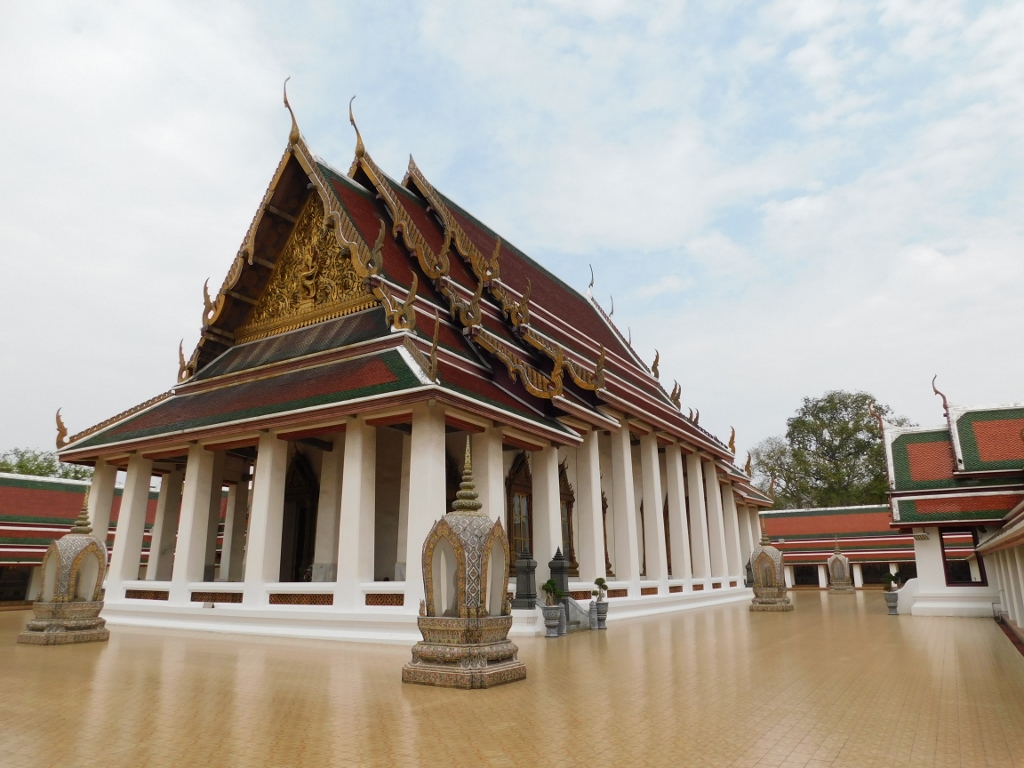 Wat Saket: ubosot surrounded by a gallery
Wat Saket: ubosot surrounded by a gallery
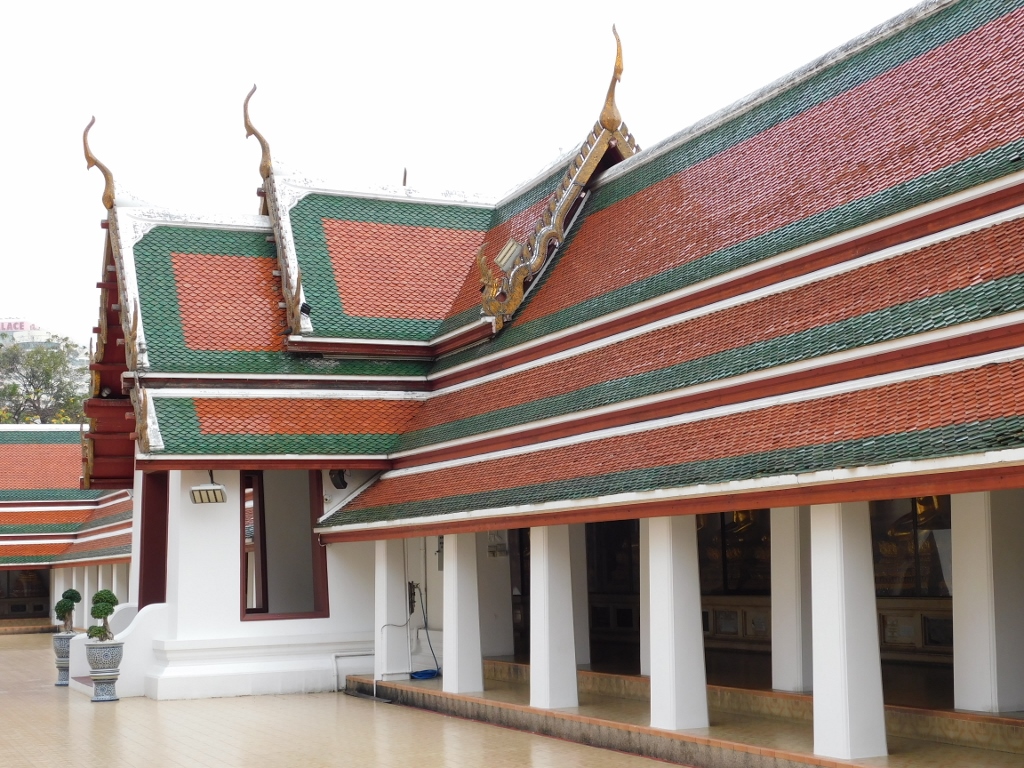 Wat Saket: part of the gallery
Wat Saket: part of the gallery
Along the gallery that surrounds the rectangular courtyard, as is the case with all other temple galleries, seemingly countless statues of Buddha can be seen, as well as various other details.
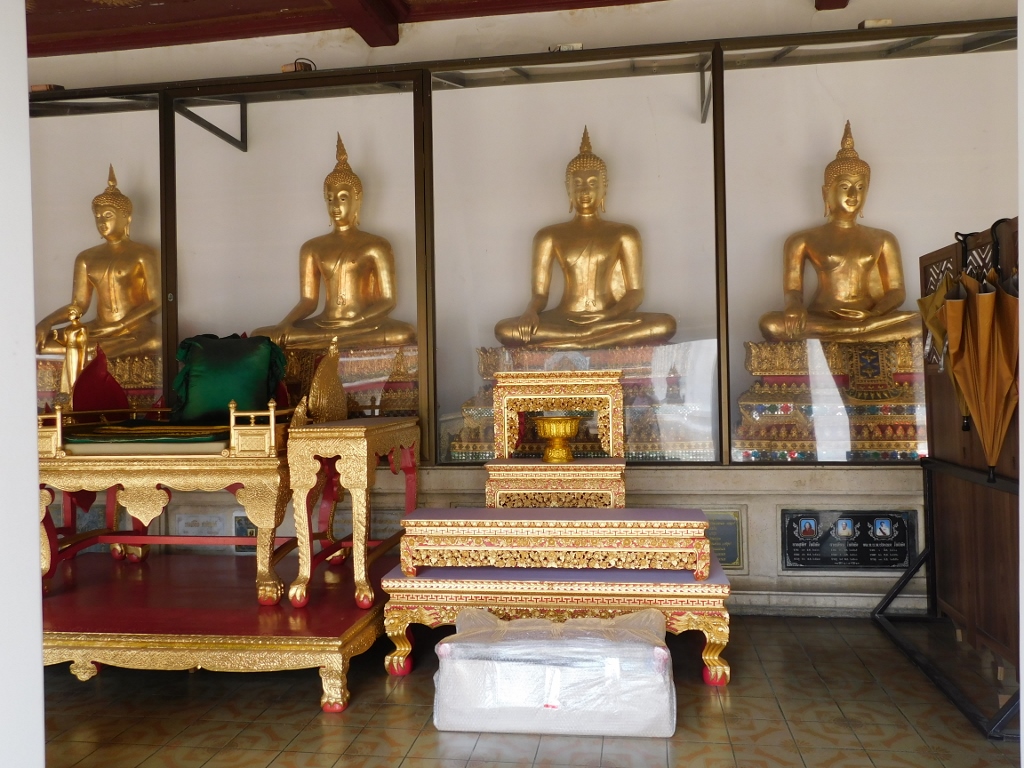 Wat Saket: part of the gallery
Wat Saket: part of the gallery
I entered the ubosot from the back side, simply because that’s how I approached the building in the first place.
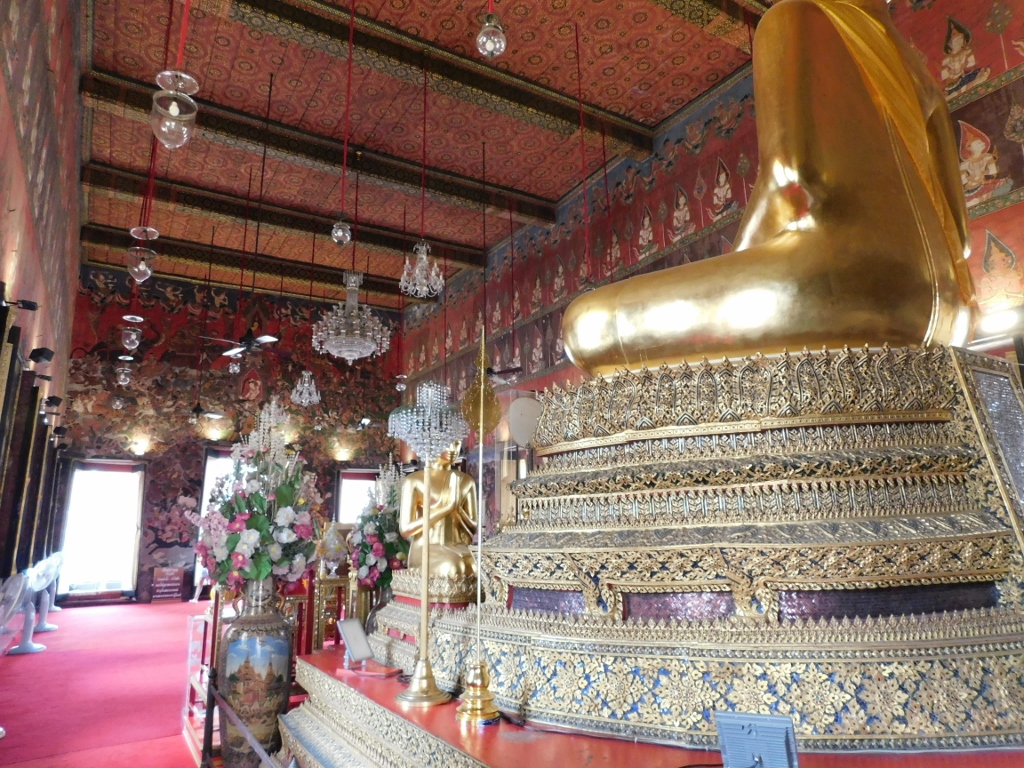 Wat Saket: the ubosot
Wat Saket: the ubosot
I first started to explore it in a general way and only then did I plan to delve into the details, but my attention was immediately drawn to two women who were praying here.
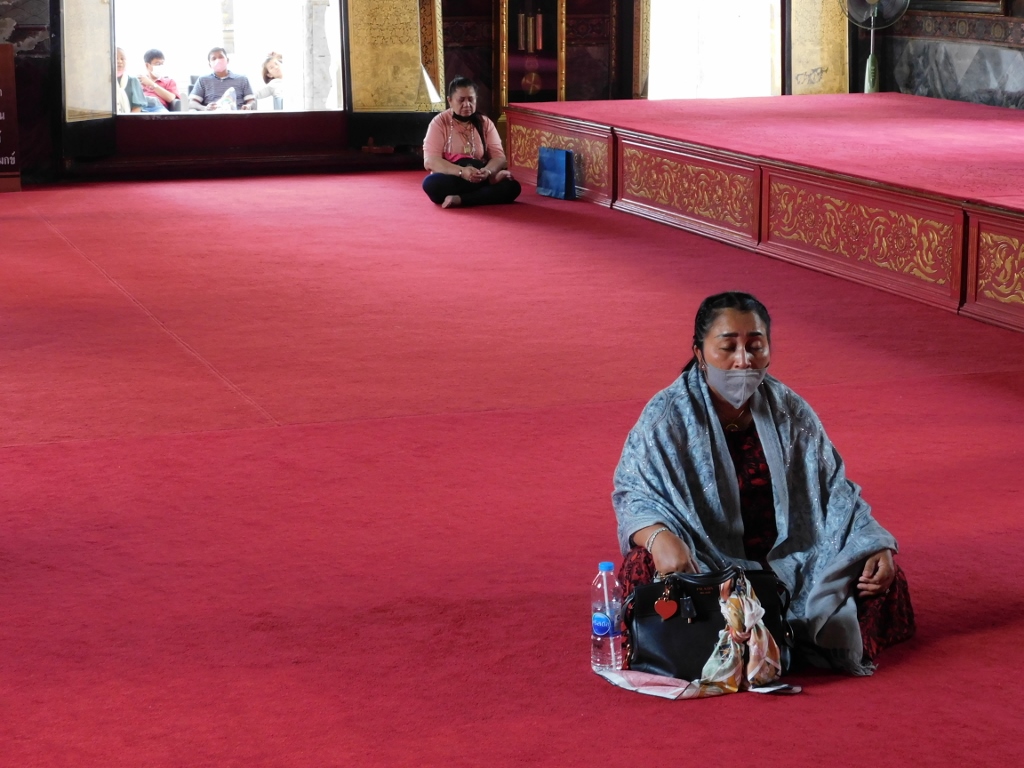 Wat Saket: prayer in the ubosot
Wat Saket: prayer in the ubosot
The ubosot in Wat Saket is known for its richly decorated walls. In the next picture, in addition to the decoration, attention should be paid to the platform intended only for monks, while visitors are not supposed to sit or climb there. Such is a custom and then it is a matter of basic courtesy and respect.
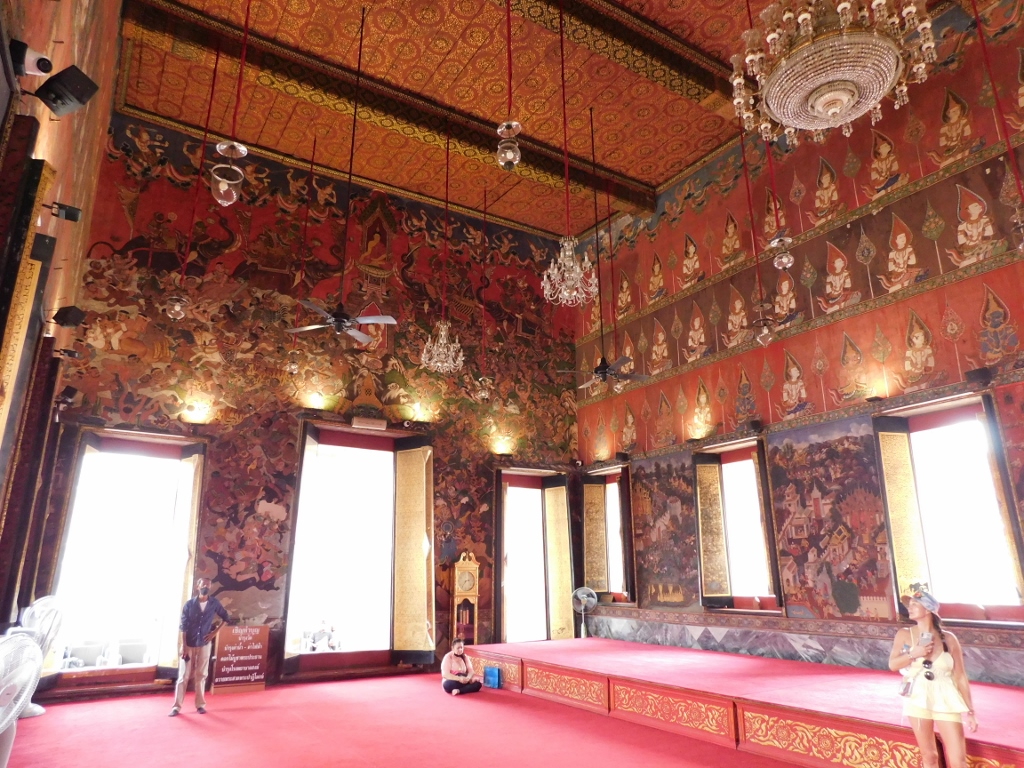 Wat Saket: the ubosot
Wat Saket: the ubosot
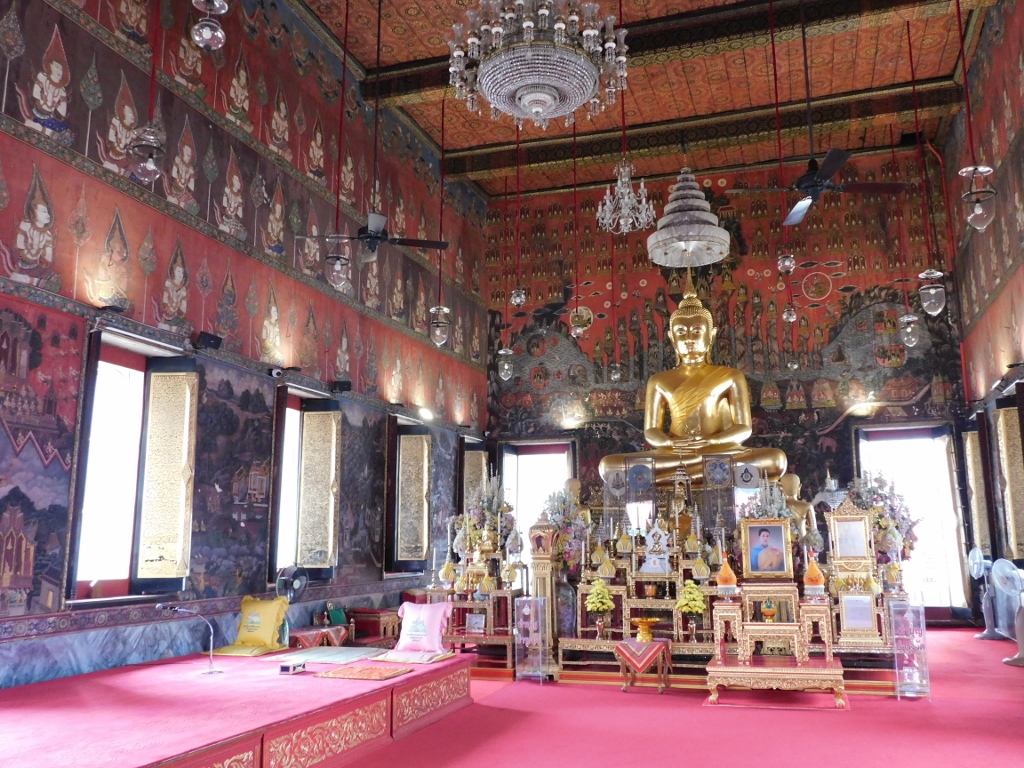 Wat Saket: the ubosot
Wat Saket: the ubosot
Guidebooks particularly emphasise the wall decoration that can be seen in the passage behind the Buddha’s back, where, among other things, scenes depicting the Buddhist hell can be seen. I immediately thought of Hieronymus Bosch.
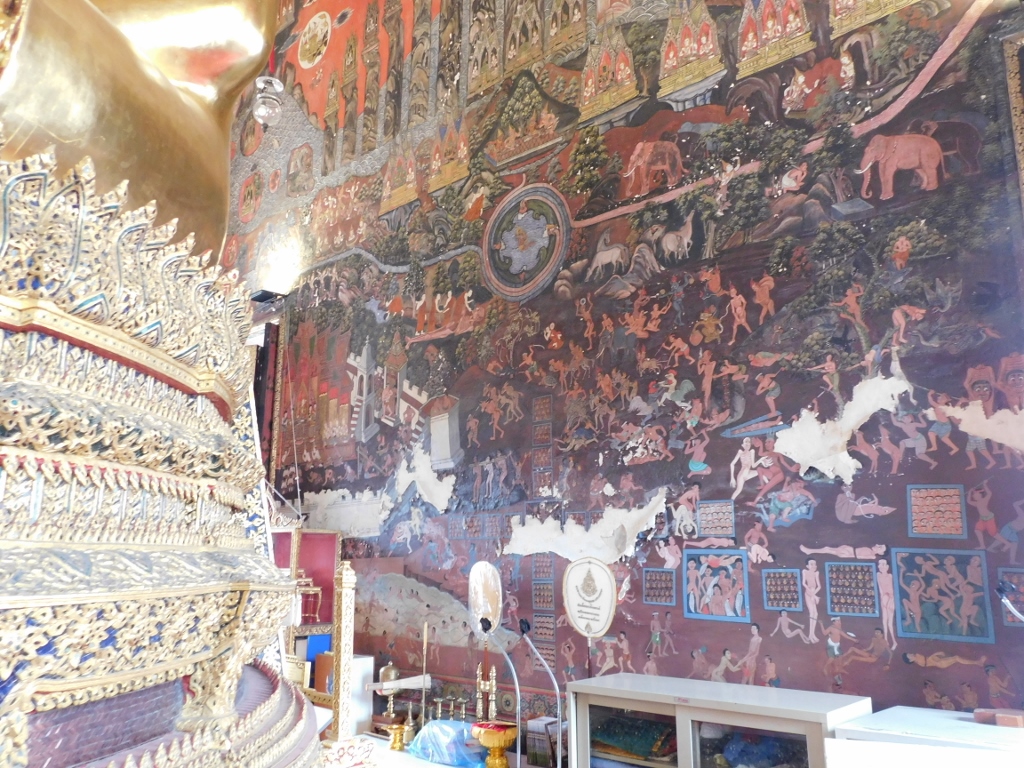 Wat Saket: the ubosot, a detail
Wat Saket: the ubosot, a detail
After visiting the ubosot, I first went to retrieve my shoes. Using the ambulatory passage, I then reached the main entrance to the ubosot and admired the Buddha statue again, along with the wall decorations and the richly adorned portal.
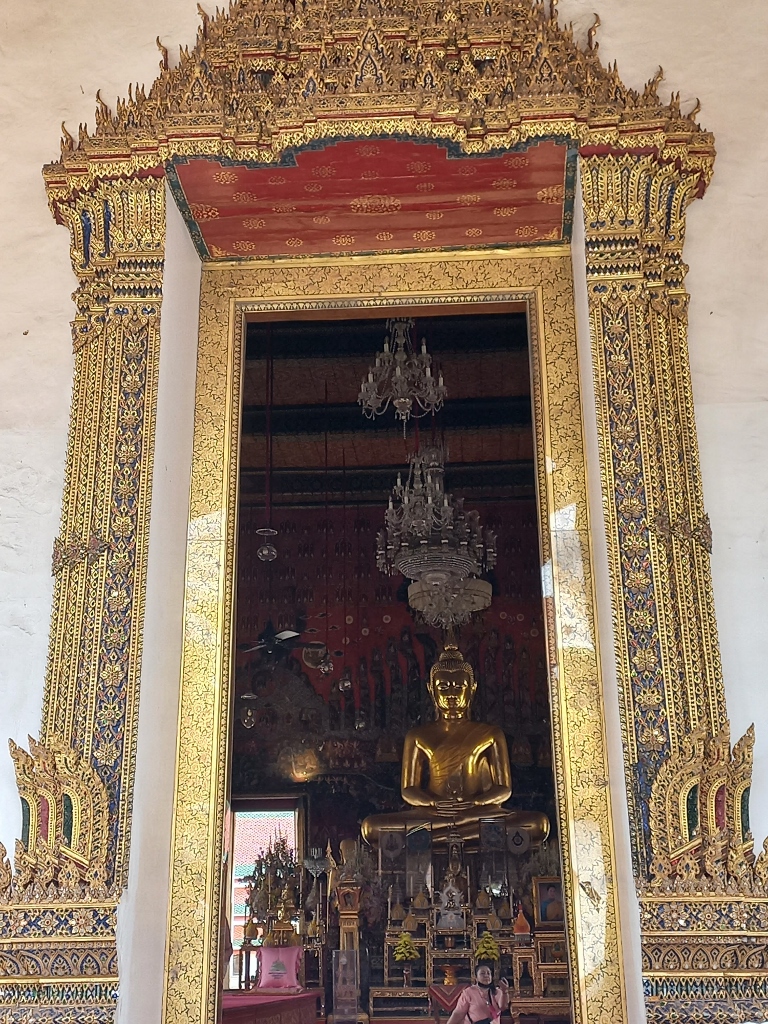 Wat Saket: the ubosot, a detail
Wat Saket: the ubosot, a detail
Next, I took a short stroll through the courtyard around the ubosot, still filled with unabated admiration.
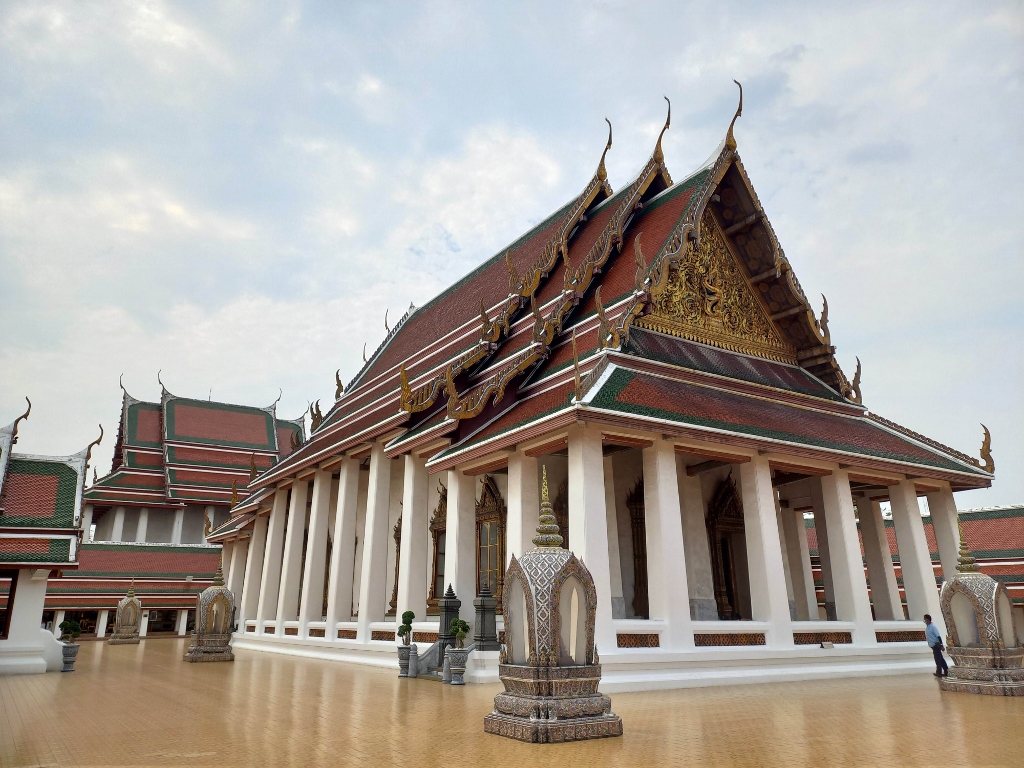 Wat Saket: ubosot and a little farther (on the left-hand side) is the vihara
Wat Saket: ubosot and a little farther (on the left-hand side) is the vihara
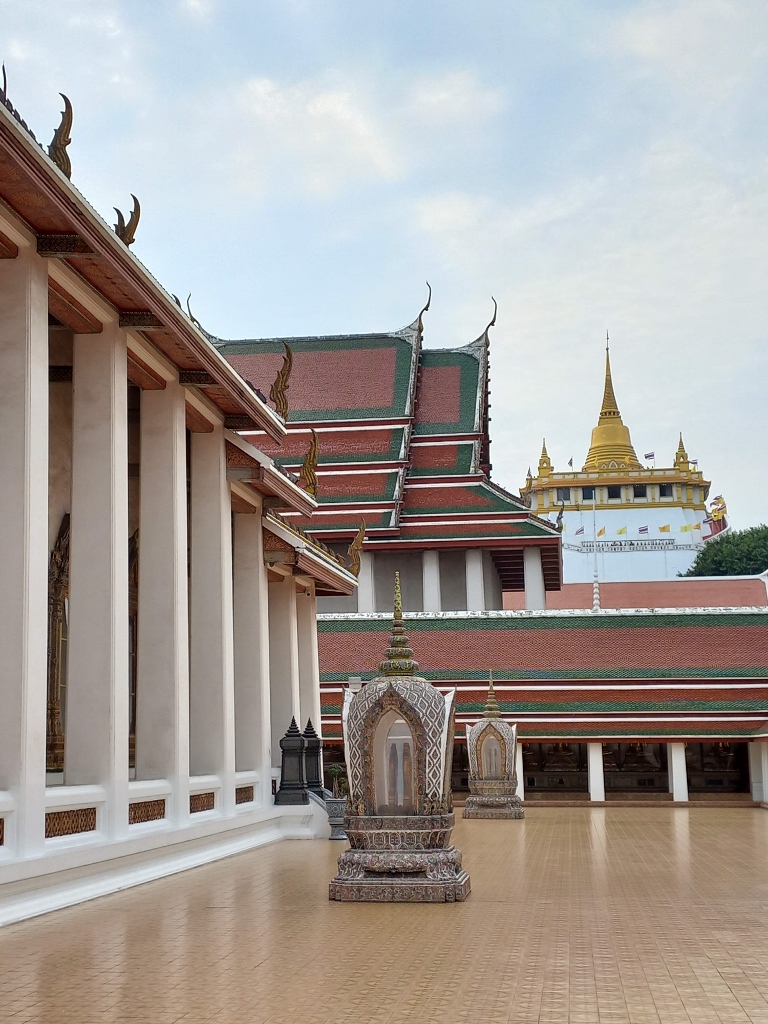 Wat Saket: ubosot and a little father are the vihara (middle) and the Golden Mount
Wat Saket: ubosot and a little father are the vihara (middle) and the Golden Mount
When I exited the courtyard, I once again turned towards the ubosot of the Wat Saket temple and then I headed towards the exit of this monastery-temple complex, with the idea of visiting a few more places along the way that are considered important.
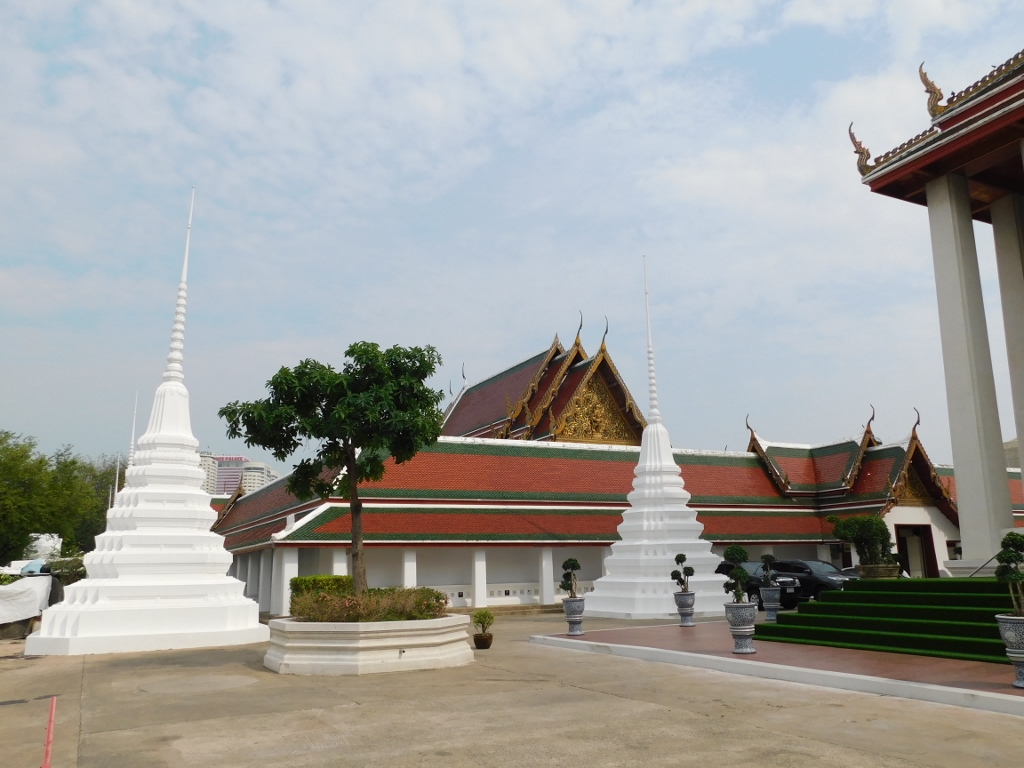 Wat Saket: couple of chedis in front of the gallery that surrounds the ubosot
Wat Saket: couple of chedis in front of the gallery that surrounds the ubosot